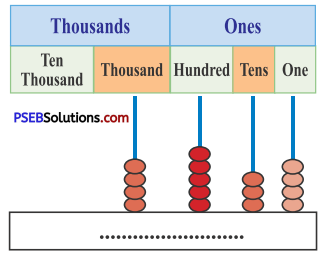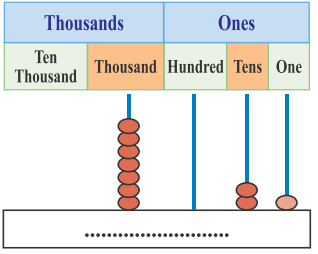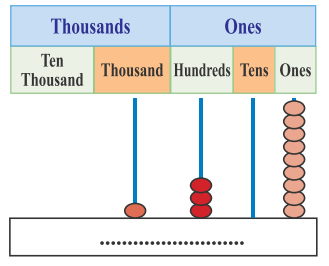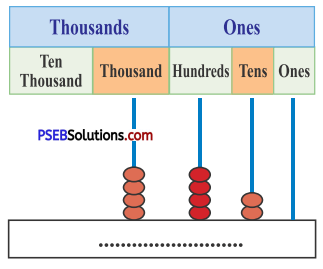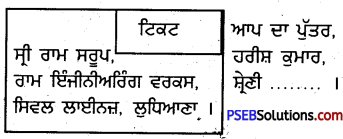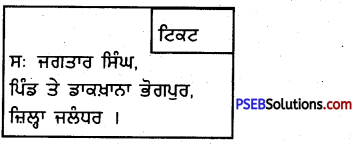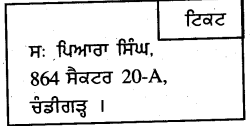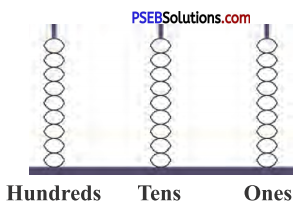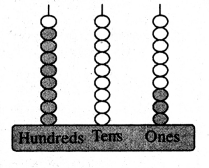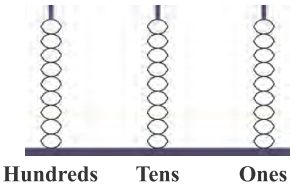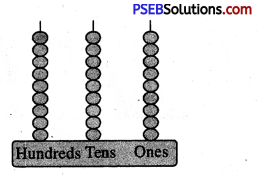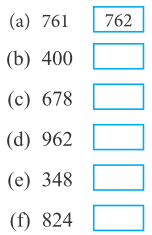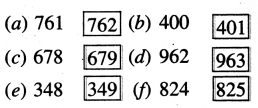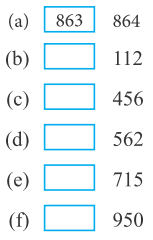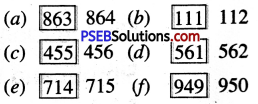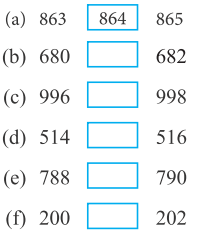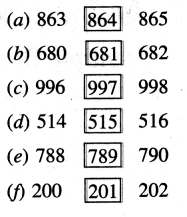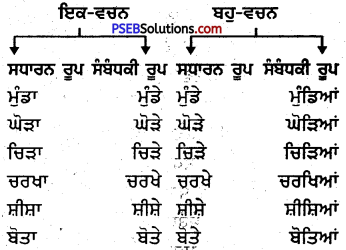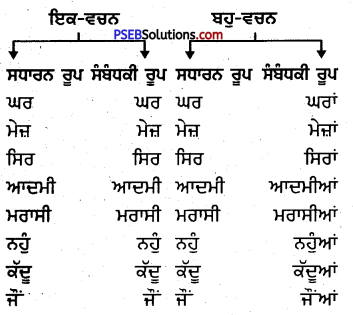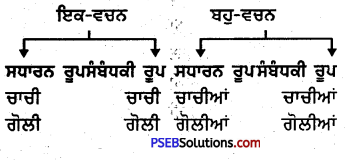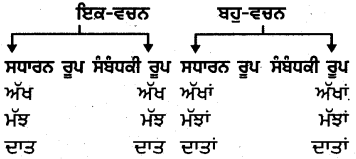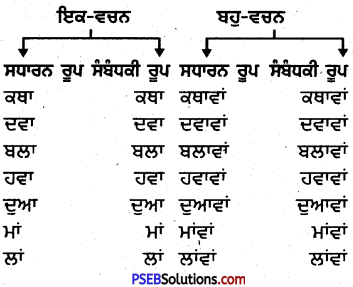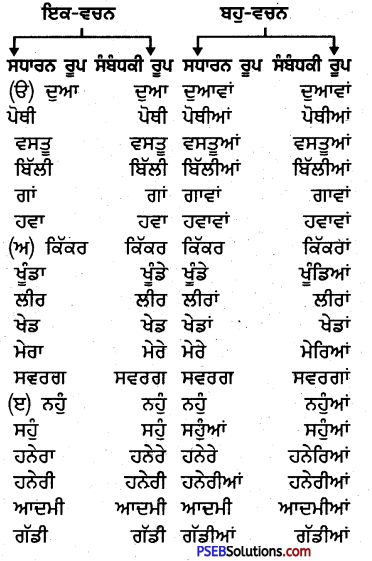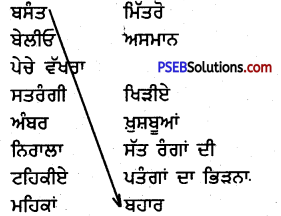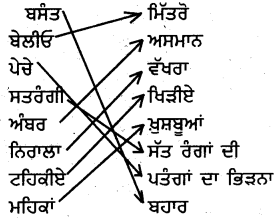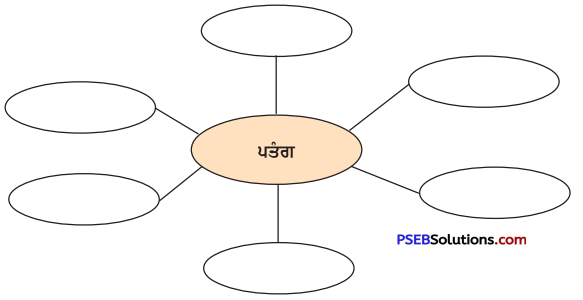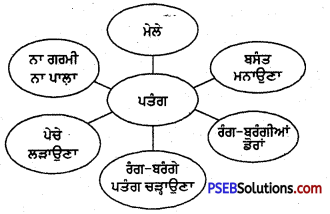Punjab State Board PSEB 4th Class Punjabi Book Solutions Punjabi Rachana ਲੇਖ-ਰਚਨਾ Exercise Questions and Answers.
PSEB 4th Class Punjabi Rachana ਲੇਖ-ਰਚਨਾ
1. ਮੇਰਾ ਸਕੂਲ (V. V. Imp.)
ਮੇਰੇ ਸਕੂਲ ਦਾ ਨਾਂ ਖ਼ਾਲਸਾ ਸੀਨੀਅਰ ਸੈਕੰਡਰੀ ਸਕੂਲ ਹੈ । ਇਹ ਜਲੰਧਰ ਸ਼ਹਿਰ ਵਿਚ ਨਕੋਦਰ ਰੋਡ ਉੱਤੇ ਸਥਿਤ ਹੈ । ਇਸ ਦੀ ਇਮਾਰਤ ਬਹੁਤ ਵੱਡੀ ਹੈ । ਇਹ ਬਾਹਰੋਂ ਦੇਖਣ ਨੂੰ ਬਹੁਤ ਸੁੰਦਰ ਹੈ । ਇਸ ਦੇ 25 ਤੋਂ ਵੱਧ ਕਮਰੇ ਹਨ ।ਇਕ ਵੱਡਾ ਹਾਲ ਹੈ । ਇਸ ਵਿਚ ਇਕ ਵੱਡੀ ਲਾਇਬਰੇਰੀ ਵੀ ਹੈ ।
ਇਸ ਸਕੂਲ ਵਿਚ 800 ਵਿਦਿਆਰਥੀ ਪੜ੍ਹਦੇ ਹਨ ।
ਉਨ੍ਹਾਂ ਨੂੰ ਪੜ੍ਹਾਉਣ ਲਈ 30 ਅਧਿਆਪਕ ਹਨ । ਇੱਥੋਂ ਦੇ ਮੁੱਖ ਅਧਿਆਪਕ ਸਾਹਿਬ ਬੜੇ ਲਾਇਕ ਤੇ ਤਜਰਬੇਕਾਰ ਹਨ ।
ਇਸ ਸਕੂਲ ਦੀ ਸਭ ਤੋਂ ਵੱਡੀ ਵਿਸ਼ੇਸ਼ਤਾ ਇਸ ਵਿਚ ਵਿਦਿਆਰਥੀਆਂ ਦੁਆਰਾ ਅਨੁਸ਼ਾਸਨ ਦੀ ਪਾਲਣਾ ਹੈ । ਅਧਿਆਪਕ ਅਤੇ ਵਿਦਿਆਰਥੀ ਸਮੇਂ ਸਿਰ ਸਕੂਲ ਪੁੱਜਦੇ ਹਨ । ਅਧਿਆਪਕ ਪੂਰੀ ਮਿਹਨਤ ਨਾਲ ਪੜ੍ਹਾਉਂਦੇ ਹਨ । ਇਹ ਉਨ੍ਹਾਂ ਦੀ ਮਿਹਨਤ ਦਾ ਸਿੱਟਾ ਹੈ ਕਿ ਇਸ ਸਕੂਲ ਦੇ ਨਤੀਜੇ ਹਰ ਸਾਲ ਚੰਗੇ ਰਹਿੰਦੇ ਹਨ |
ਇਸ ਸਕੂਲ ਦਾ ਬਗੀਚਾ ਹਰਾ-ਭਰਾ ਤੇ ਫੁੱਲਾਂ ਨਾਲ ਲੱਦਿਆ ਪਿਆ ਹੈ । ਇਸ ਸਕੂਲ ਦੀ ਬਿਲਡਿੰਗ ਨਵੀਂ ਹੈ, ਜਿਸ ਵਿਚ ਕਮਰੇ ਖੁੱਲ੍ਹੇ ਤੇ ਹਵਾਦਾਰ ਹਨ । ਇਸ ਸਕੂਲ ਕੋਲ ਹਾਕੀ, ਫੁੱਟਬਾਲ, ਬਾਸਕਟਬਾਲ ਤੇ ਕ੍ਰਿਕਟ ਖੇਡਣ ਲਈ ਖੁੱਲ੍ਹੀਆਂ ਤੇ ਪੱਧਰੀਆਂ ਗਰਾਊਂਡਾਂ ਹਨ । ਮੈਂ ਆਪਣੇ ਇਸ ਸਕੂਲ ਨੂੰ ਬਹੁਤ ਪਿਆਰ ਕਰਦਾ ਹਾਂ ।
2. ਮੇਰਾ ਮਿੱਤਰ (V. V. Imp.)
ਅਰਸ਼ਦੀਪ ਮੇਰਾ ਮਿੱਤਰ ਹੈ । ਉਹ ਮੇਰਾ ਸਹਿਪਾਠੀ ਹੈ । ਅਸੀਂ ਦੋਵੇਂ ਚੌਥੀ ਜਮਾਤ ਵਿਚ ਪੜ੍ਹਦੇ ਹਾਂ ਅਸੀਂ ਦੋਵੇਂ ਇੱਕੋ ਡੈਸਕ ਉੱਤੇ ਬੈਠਦੇ ਹਾਂ ਅਸੀਂ ਦੋਵੇਂ ਵੱਧ ਤੋਂ ਵੱਧ ਸਮਾਂ ਇਕੱਠੇ ਰਹਿੰਦੇ ਹਾਂ । ਰਾਤ ਨੂੰ ਵੀ ਅਸੀਂ ਇਕੱਠੇ ਪੜ੍ਹਦੇ ਹਾਂ ।
ਉਸ ਦੇ ਮਾਤਾ-ਪਿਤਾ ਬਹੁਤ ਨੇਕ ਵਿਅਕਤੀ ਹਨ । ਉਸ ਦਾ ਪਿਤਾ ਇਕ ਪ੍ਰੋਫ਼ੈਸਰ ਹੈ । ਉਸ ਦੀ ਮਾਤਾ ਇਕ ਧਰਮਾਤਮਾ ਇਸਤਰੀ’ ਹੈ ।
ਮੇਰਾ ਮਿੱਤਰ ਪੜ੍ਹਾਈ ਵਿਚ ਬਹੁਤ ਹੁਸ਼ਿਆਰ ਹੈ । ਉਹ ਹਰ ਸਾਲ ਕਲਾਸ ਵਿਚੋਂ ਅੱਵਲ ਰਹਿੰਦਾ ਹੈ ਤੇ ਇਨਾਮ ਪ੍ਰਾਪਤ ਕਰਦਾ ਹੈ । ਉਹ ਹਿਸਾਬ ਅਤੇ ਅੰਗਰੇਜ਼ੀ ਵਿਚ ਬਹੁਤ ਹੀ ਹੁਸ਼ਿਆਰ ਹੈ ।
ਸਕੂਲ ਤੋਂ ਘਰ ਆ ਕੇ ਉਹ ਪਹਿਲਾਂ ਸਕੂਲ ਦਾ ਸਾਰਾ ਕੰਮ ਮੁਕਾਉਂਦਾ ਹੈ ਉਹ ਕਿਤਾਬੀ-ਕੀੜਾ ਨਹੀਂ । ਉਹ ਹਰ ਰੋਜ਼ ਫੁੱਟਬਾਲ ਖੇਡਣ ਜਾਂਦਾ ਹੈ ।
ਉਹ ਇਕ ਨੇਕ ਤੇ ਵਫ਼ਾਦਾਰ ਮਿੱਤਰ ਹੈ । ਉਸ ਦਾ ਸਰੀਰ ਸੁੰਦਰ ਅਤੇ ਤਕੜਾ ਹੈ । ਉਹ ਹਰ ਸਮੇਂ ਮੇਰੀ ਸਹਾਇਤਾ ਕਰਨ ਲਈ ਤਿਆਰ ਰਹਿੰਦਾ ਹੈ । ਸਕੂਲ ਦੇ ਸਾਰੇ ਅਧਿਆਪਕ ਅਤੇ ਮੁੱਖ ਅਧਿਆਪਕ ਸਾਹਿਬ ਉਸ ਨੂੰ ਬਹੁਤ ਪਿਆਰ ਕਰਦੇ ਹਨ । ਮੈਨੂੰ ਆਪਣੇ ਇਸ ਮਿੱਤਰ ਉੱਤੇ ਬਹੁਤ ਮਾਣ ਹੈ ।

3. ਮੇਰਾ ਬਸਤਾ
ਇਹ ਮੇਰਾ ਬਸਤਾ ਹੈ । ਇਸ ਦਾ ਰੰਗ ਨੀਲਾ ਹੈ । ਇਹ ਮੋਟੇ ਕੱਪੜੇ ਦਾ ਬਣਿਆ ਹੋਇਆ ਹੈ । ਇਸ ਵਿਚ ਦੋ ਵੱਡੇ ਖ਼ਾਨੇ ਹਨ ਤੇ ਇਕ ਜਿਪ ਵਾਲੀ ਜੇਬ ਹੈ । ਇਸ ਦੇ ਬਾਹਰ ਜਿੰਦਰਾ ਲਾਉਣ ਲਈ ਇਕ ਕੁੰਡੀ ਲੱਗੀ ਹੋਈ ਹੈ । ਇਹ ਹਰ ਸਮੇਂ ਕਿਤਾਬਾਂ, ਕਾਪੀਆਂ ਤੇ ਲਿਖਣ-ਪੜ੍ਹਨ ਦੇ ਹੋਰ ਸਮਾਨ ਨਾਲ ਭਰਿਆ ਰਹਿੰਦਾ ਹੈ । ਮੈਂ ਆਪਣਾ ਰੋਟੀ ਦਾ ਡੱਬਾ ਵੀ ਇਸੇ ਵਿਚ ਹੀ ਰੱਖਦਾ ਹਾਂ ।
ਮੈਂ ਐਤਵਾਰ ਵਾਲੇ ਦਿਨ ਇਸ ਨੂੰ ਧੁਆਉਂਦਾ ਹਾਂ । ਇਹ ਆਮ ਕਰਕੇ ਭਾਰਾ ਹੁੰਦਾ ਹੈ । ਮੈਂ ਇਸ ਦੀਆਂ ਤਣੀਆਂ ਨੂੰ ਮੋਢਿਆਂ ‘ਤੇ ਪਾ ਕੇ ਤੇ ਇਸ ਨੂੰ ਪਿੱਠ ਉੱਤੇ ਚੁੱਕ ਕੇ ਸਕੂਲ ਜਾਂਦਾ ਹਾਂ । ਮੈਂ ਇਸ ਦੀ ਜੇਬ ਵਿਚ ਕੁੱਝ ਪੈਸੇ ਰੱਖਦਾ ਹਾਂ । ਇਹ ਸਕੂਲ ਵਿਚ ਮੇਰਾ ਪੱਕਾ ਸਾਥੀ ਹੈ । ਸਕੂਲ ਵਿਚ ਮੈਂ ਇਸ ਦਾ ਪੂਰਾ ਧਿਆਨ ਰੱਖਦਾ ਹਾਂ, ਤਾਂ ਜੋ ਇਸ ਵਿਚੋਂ ਕੋਈ ਚੀਜ਼ ਚੋਰੀ ਨਾ ਹੋ ਜਾਵੇ । ਮੈਂ ਇਸ ਨੂੰ ਮੈਲਾ ਹੋਣ ਤੋਂ ਵੀ ਬਚਾਉਂਦਾ ਹਾਂ । ਜਦੋਂ ਕਦੇ ਇਸ ਦੀ ਕੋਈ ਤਣੀ ਟੁੱਟ ਜਾਂਦੀ ਹੈ ਜਾਂ ਇਸ ਦੀ ਸੀਉਣ ਉੱਧੜ ਜਾਂਦੀ ਹੈ, ਤਾਂ ਮੈਂ ਇਸ ਦੀ ਮੁਰੰਮਤ ਕਰਾ ਲੈਂਦਾ ਹਾਂ । ਮੇਰਾ ਬਸਤਾ ਮੇਰੇ ਲਈ ਗਿਆਨ ਦਾ ਭੰਡਾਰ ਹੈ । ਇਸ ਨੂੰ ਮੋਢਿਆਂ ‘ਤੇ ਚੁੱਕ ਕੇ ਮੈਂ ਬੜੇ ਮਾਣ ਨਾਲ ਸਕੂਲ ਜਾਂਦਾ ਤੇ ਆਉਂਦਾ ਹਾਂ ।
4. ਮੇਰਾ ਅਧਿਆਪਕ
ਉਂਝ ਤਾਂ ਸਾਡੇ ਸਕੂਲ ਦੇ ਸਾਰੇ ਅਧਿਆਪਕ ਹੀ ਬੜੇ ਸਤਿਕਾਰਯੋਗ ਹਨ, ਪਰ ਮੇਰਾ ਮਨ-ਭਾਉਂਦਾ ਅਧਿਆਪਕ ਸਾਡਾ ਮੁੱਖ ਅਧਿਆਪਕ ਹੈ ।ਉਨ੍ਹਾਂ ਦਾ ਨਾਂ ਸ: ਹਰਜਿੰਦਰ ਸਿੰਘ ਹੈ । ਉਨ੍ਹਾਂ ਨੇ ਐੱਮ. ਏ., ਬੀ. ਐੱਡ. ਤਕ ਵਿੱਦਿਆ ਹਾਸਲ ਕੀਤੀ ਹੋਈ ਹੈ । ਉਹ ਸਾਨੂੰ ਹਿਸਾਬ ਪੜ੍ਹਾਉਂਦੇ ਹਨ ।
ਉਨ੍ਹਾਂ ਵਿਚ ਸਭ ਤੋਂ ਵੱਡੀ ਵਿਸ਼ੇਸ਼ਤਾ ਉਨ੍ਹਾਂ ਦੇ ਪੜ੍ਹਾਉਣ ਦਾ ਵਧੀਆ ਢੰਗ ਹੈ । ਉਨ੍ਹਾਂ ਦੀ ਪੜ੍ਹਾਈ ਹੋਈ ਇਕ-ਇਕ ਚੀਜ਼ ਵਿਦਿਆਰਥੀਆਂ ਨੂੰ ਚੰਗੀ ਤਰ੍ਹਾਂ ਯਾਦ ਹੋ ਜਾਂਦੀ ਹੈ ।ਉਹ ਔਖੇ ਪ੍ਰਸ਼ਨਾਂ ਅਤੇ ਤਰੀਕਿਆਂ ਨੂੰ ਸਮਝਾਉਣ ਲਈ ਬੜੇ ਸਰਲ ਤੇ ਸੌਖੇ ਢੰਗਾਂ ਦੀ ਵਰਤੋਂ ਕਰਦੇ ਹਨ ।
ਉਹ ਵਿਦਿਆਰਥੀਆਂ ਨਾਲ ਬਹੁਤ ਪਿਆਰ ਰੱਖਦੇ ਹਨ । ਉਹ ਕਿਸੇ ਵਿਦਿਆਰਥੀ ਨੂੰ ਕੋਈ ਚੀਜ਼ ਸਮਝ ਵਿਚ ਨਾ ਆਉਣ ‘ਤੇ ਮਾਰਦੇ-ਕੁੱਟਦੇ ਨਹੀਂ, ਸਗੋਂ ਪਿਆਰ ਤੇ ਹਮਦਰਦੀ ਨਾਲ ਵਾਰ-ਵਾਰ ਸਮਝਾਉਂਦੇ ਹਨ । ਉਹ ਹਰ ਰੋਜ਼ ਸਮੇਂ ਸਿਰ ਸਕੂਲ ਪੁੱਜਦੇ ਤੇ ਪ੍ਰਾਰਥਨਾ ਵਿਚ ਸ਼ਾਮਲ ਹੁੰਦੇ ਹਨ । ਉਹ ਸਾਡੀ ਕਲਾਸ ਦੇ ਇੰਚਾਰਜ ਵੀ ਹਨ । ਉਹ ਅਰੋਗ ਸਰੀਰ ਦੇ ਮਾਲਕ ਹਨ । ਉਹ ਹਰ ਇਕ ਨਾਲ ਮਿੱਤਰਤਾ ਤੇ ਪਿਆਰ ਰੱਖਦੇ ਹਨ । ਸਕੂਲ ਦੇ ਸਾਰੇ ਅਧਿਆਪਕ ਉਨ੍ਹਾਂ ਦੇ ਹੁਕਮਾਂ ਦੀ ਪਾਲਣਾ ਕਰਦੇ ਹਨ । ਉਨ੍ਹਾਂ ਦੀਆਂ ਕਲਾਸਾਂ ਦੇ ਨਤੀਜੇ ਹਰ ਸਾਲ ਸ਼ਾਨਦਾਰ ਆਉਂਦੇ ਹਨ । ਇਸ ਕਰਕੇ ਉਹ ਮੇਰੇ ਮਨ-ਭਾਉਂਦੇ ਅਧਿਆਪਕ ਹਨ ।
5. ਮੇਰਾ ਘਰ
ਮੇਰਾ ਘਰ ਸੁੰਦਰ ਹੈ । ਇਸ ਦਾ ਨੰਬਰ 1108 ਹੈ ਤੇ ਇਹ ਗੁਜਰਾਲ ਨਗਰ ਜਲੰਧਰ ਵਿਚ ਸਥਿਤ ਹੈ । ਬਾਹਰੋਂ ਇਸ ਦਾ ਰੰਗ ਚਿੱਟਾ ਦਿਖਾਈ ਦਿੰਦਾ ਹੈ, ਪਰ ਅੰਦਰਲੇ ਕਮਰਿਆਂ ਦਾ ਰੰਗ ਹਲਕਾ ਕਰੀਮ ਹੈ ! ਇਸ ਘਰ ਵਿਚ ਮੈਂ ਆਪਣੇ ਮਾਤਾ-ਪਿਤਾ ਅਤੇ ਇਕ, ਭੈਣ ਤੇ ਇਕ ਭਰਾ ਨਾਲ ਰਹਿੰਦਾ ਹਾਂ । ਇਸ ਘਰ ਵਿਚ ਇਕ ਬੈਠਕ, ਇਕ ਖਾਣਾ ਖਾਣ ਵਾਲਾ ਕਮਰਾ, ਤਿੰਨ ਸੌਣ ਵਾਲੇ ਕਮਰੇ, ਇਕ ਰਸੋਈ ਅਤੇ ਦੋ ਗੁਸਲਖ਼ਾਨੇ ਹਨ । ਇਸ ਦੇ ਵਿਹੜੇ ਵਿਚ ਇਕ ਖੁੱਲ੍ਹਾ ਹਰੇ ਘਾਹ ਦਾ ਲਾਅਨ ਹੈ । ਇਸ ਦਾ ਇਕ ਪਾਸਾ ਗਲੀ ਨਾਲ ਲੱਗਦਾ ਹੈ ਤੇ ਦੂਜਾ ਪਾਸਾ ਮਾਰਕੀਟ ਦੀ ਸੜਕ ਨਾਲ਼ ਜਲੰਧਰ ਟੈਲੀਵਿਜ਼ਨ ਕੇਂਦਰ ਇਸ ਦੇ ਬਿਲਕੁਲ ਕੋਲ ਹੈ । ਮੇਰਾ ਘਰ ਫੁੱਲਾਂ ਤੇ, ਸਦਾ-ਬਹਾਰ ਬੂਟਿਆਂ ਦੇ ਗਮਲਿਆਂ ਨਾਲ ਭਰਿਆ ਹੋਇਆ ਹੈ । ਇਹ ਬੜਾ ਹਵਾਦਾਰ ਤੇ ਰੌਸ਼ਨੀ ਭਰਪੂਰ ਹੈ । ਰਾਤ ਨੂੰ ਰੌਸ਼ਨੀ ਕਰਨ ਲਈ ਇਸ ਵਿਚ ਬਿਜਲੀ ਦੇ ਬਲਬ ਤੇ ਟਿਊਬਾਂ ਲੱਗੀਆਂ ਹੋਈਆਂ ਹਨ । ‘ ਮੇਰੇ ਘਰ ਵਿਚ ਇਕ ਰੰਗਦਾਰ ਟੈਲੀਵਿਜ਼ਨ, ਇਕ ਸਕੂਟਰ, ਇਕ ਕਾਰ, ਮਾਈਕਰੋਵੇਵ, ਇਕ ਫ਼ਰਿਜ਼, ਭਿੰਨ-ਭਿੰਨ ਪ੍ਰਕਾਰ ਦੇ ਭਾਂਡੇ ਤੇ ਕਰਾਕਰੀ, ਰੇਡੀਓ, ਬਿਜਲੀ ਦੇ ਪੱਖੇ, ਕੁਰਸੀਆਂ, ਸੋਫ਼ੇ ਤੇ ਮੇਜ਼ ਹਨ ।
ਮੇਰੇ ਮਾਤਾ ਜੀ ਘਰ ਦੀ ਸਫ਼ਾਈ ਆਪ ਵੀ ਕਰਦੇ ਹਨ ਤੇ ਨੌਕਰਾਂ ਤੋਂ ਵੀ ਕਰਾਉਂਦੇ ਹਨ । ਮੈਂ ਜਦੋਂ ਕਦੇ ਘਰੋਂ ਬਾਹਰ ਜਾਂਦਾ ਹਾਂ, ਤਾਂ ਮੇਰਾ, ਇੱਥੇ ਵਾਪਸ ਪਰਤਣ ਲਈ ਮਨ ਕਾਹਲਾ ਪੈ ਜਾਂਦਾ ਹੈ । ਮੇਰਾ ਆਪਣੇ ਘਰ ਨਾਲ ਬਹੁਤ ਪਿਆਰ ਹੈ ।
6. ਮੇਰੇ ਮਾਤਾ ਜੀ
ਮੇਰੇ ਮਾਤਾ ਜੀ ਦਾ ਨਾਂ ਸ੍ਰੀਮਤੀ ਦਲਜੀਤ ਕੌਰ ਹੈ । ਉਨ੍ਹਾਂ ਦੀ ਉਮਰ 35 ਸਾਲ ਹੈ । ਉਨ੍ਹਾਂ ਦੀ ਸਿਹਤ ਬਹੁਤ ਚੰਗੀ ਹੈ ।ਉਹ ਬੜੇ ਸਾਫ਼-ਸੁਥਰੇ ਕੱਪੜੇ ਪਾਉਂਦੇ ਹਨ । ਦੁਨੀਆ ਭਰ ਦੀਆਂ ਇਸਤਰੀਆਂ ਵਿਚੋਂ ਉਹ ਸਭ ਤੋਂ ਸੋਹਣੇ ਹਨ ।
ਉਹ ਐੱਮ. ਏ., ਐੱਮ. ਐੱਡ. ਪੜ੍ਹੇ ਹੋਏ ਹਨ । ਉਹ ਇਕ ਸੀਨੀਅਰ ਸੈਕੰਡਰੀ ਸਕੂਲ ਵਿਚ ਪੜ੍ਹਾਉਂਦੇ ਹਨ । ਉਹ ਹਰਮਨ ਪਿਆਰੇ ਤੇ ਸਤਿਕਾਰਯੋਗ ਅਧਿਆਪਕਾ ਹਨ । ਉਹ ਸਮੇਂ ਦੇ ਬੜੇ ਪਾਬੰਦ ਹਨ । ਉਹ ਸਾਡੇ ਲਈ ਖਾਣਾ ਬਣਾਉਂਦੇ, ਕੱਪੜੇ ਧੋਦੇ ਤੇ ਸਾਡੀ ਹਰ ਇਕ ਲੋੜ ਦਾ ਖ਼ਿਆਲ ਰੱਖਦੇ ਹਨ । ਉਹ ਤਰ੍ਹਾਂ-ਤਰ੍ਹਾਂ ਦੇ ਖਾਣੇ ਬਣਾਉਣੇ ਜਾਣਦੇ ਹਨ । ਉਹ ਸਿਲਾਈ-ਕਢਾਈ ਵੀ ਜਾਣਦੇ ਹਨ। ਉਹ ਸਾਡੀ ਗਲੀ ਵਿਚ ਵੀ ਬਹੁਤ ਹਰਮਨ ਪਿਆਰੇ ਹਨ ।ਉਹ ਮੁਹੱਲੇ ਦੀ ਇਸਤਰੀ ਸਭਾ ਦੇ ਪ੍ਰਧਾਨ ਹਨ । ਉਨ੍ਹਾਂ ਨੇ ਮੁਹੱਲੇ ਵਿਚ ਬੜਾ ਪਿਆਰ ਪੈਦਾ ਕੀਤਾ ਹੈ । ਉਹ ਮੇਰੇ ਪਿਤਾ ਜੀ ਦਾ ਬਹੁਤ ਸਤਿਕਾਰ ਕਰਦੇ ਹਨ । ਮੇਰੇ ਪਿਤਾ ਜੀ ਵੀ ਉਨ੍ਹਾਂ ਨੂੰ ਹਰ ਤਰ੍ਹਾਂ ਖੁਸ਼ ਰੱਖਦੇ ਹਨ । ਉਹ ਆਪਸ ਵਿਚ ਕਦੇ ਲੜਦੇ ਨਹੀਂ । ਉਹ ਆਪਣੇ ਬੱਚਿਆਂ ਨੂੰ ਬਹੁਤ ਪਿਆਰ ਕਰਦੇ ਹਨ ਤੇ ਉਨ੍ਹਾਂ ਦੇ ਭਵਿੱਖ ਦਾ ਬਹੁਤ ਖ਼ਿਆਲ ਰੱਖਦੇ ਹਨ । ਪਰਮਾਤਮਾ ਉਨ੍ਹਾਂ ਨੂੰ ਹਮੇਸ਼ਾ ਖਿੜੇ-ਮਹਿਕੇ ਰੱਖੇ ।

7. ਮੇਰੇ ਪਿਤਾ ਜੀ ।
ਮੇਰੇ ਪਿਤਾ ਜੀ ਦਾ ਨਾਂ ਸ: ਹਰਦੇਵ ਸਿੰਘ ਹੈ । ਉਨ੍ਹਾਂ ਦੀ ਉਮਰ 37 ਸਾਲ ਹੈ । ਉਨ੍ਹਾਂ ਦੀ ਸਿਹਤ ਬਹੁਤ ਚੰਗੀ ਹੈ । ਉਹ ਐੱਮ. ਏ., ਪੀ. ਐੱਚ. ਡੀ. ਹਨ ।ਉਹ ਇਕ ਕਾਲਜ ਵਿਚ ਪੰਜਾਬੀ ਦੇ ਲੈਕਚਰਾਰ ਹਨ ।ਉਹ ਇਕ ਹਰਮਨ ਪਿਆਰੇ ਅਧਿਆਪਕ ਹਨ । ਲੋਕ ਉਨ੍ਹਾਂ ਨੂੰ ਡਾਕਟਰ ਸਾਹਿਬ ਕਹਿ ਕੇ ਬੁਲਾਉਂਦੇ ਹਨ ਉਹ ਸਵੇਰੇ ਉੱਠਦੇ ਤੇ ਸੈਰ ਕਰਨ ਲਈ ਜਾਂਦੇ ਹਨ ।
ਉਹ ਹਰ ਰੋਜ਼ ਇਸ਼ਨਾਨ ਕਰਦੇ ਹਨ ਤੇ ਫਿਰ ਪਾਠ , ਕੀਤੇ ਬਿਨਾਂ ਕੁੱਝ ਖਾਂਦੇ ਨਹੀਂ । ਉਹ ਸਾਦੇ ਕੱਪੜੇ ਪਾਉਂਦੇ ਹਨ । ਉਹ ਬੜੇ ਸਫ਼ਾਈ-ਪਸੰਦ ਹਨ । ਉਹ ਸਮੇਂ ਦੇ ਬੜੇ ਪਾਬੰਦ ਹਨ । ਉਹ ਮੋਟਰ ਸਾਈਕਲ ਉੱਤੇ ਕਾਲਜ ਜਾਂਦੇ ਹਨ । ਉਹ ਸੜਕ ਉੱਤੇ ਟ੍ਰੈਫ਼ਿਕ ਨਿਯਮਾਂ ਦਾ ਪੂਰਾ-ਪੂਰਾ ਖ਼ਿਆਲ ਰੱਖਦੇ ਹਨ । ਉਹ ਸਦਾ ਸੱਚ ਬੋਲਦੇ ਹਨ ।ਉਨ੍ਹਾਂ ਦੇ ਬਹੁਤ ਸਾਰੇ ਮਿੱਤਰ ਹਨ ।ਉਹ ਮੁਹੱਲੇ ਦੀ ਭਲਾਈ-ਸਭਾ ਦੇ ਸੈਕਟਰੀ ਹਨ । ਸਾਰੇ ਮੁਹੱਲੇ ਵਾਲੇ ਉਨ੍ਹਾਂ ਦਾ ਬਹੁਤ ਸਤਿਕਾਰ ਕਰਦੇ ਹਨ । ਉਹ ਮੁਹੱਲੇ ਦੇ ਸਾਰੇ ਝਗੜੇ ਬਿਨਾਂ ਕਿਸੇ ਦਾ ਪੱਖ ਲਿਆਂ ਨਿਬੇੜਦੇ ਹਨ । ਉਹ ਰਾਤ ਨੂੰ ਹਰ ਰੋਜ਼ ਕੁੱਝ ਨਾ ਕੁੱਝ ਪੜ੍ਹਦੇ ਹਨ । ਸਵੇਰੇ ਉਹ ਅਖ਼ਬਾਰ ਪੜ੍ਹਨਾ ਬਿਲਕੁਲ ਨਹੀਂ ਭੁੱਲਦੇ । ਉਨ੍ਹਾਂ ਦੀ ਆਮ ਜਾਣਕਾਰੀ ਬਹੁਤ ਜ਼ਿਆਦਾ ਹੈ । ਉਹ ਪੰਜਾਬੀ, ਹਿੰਦੀ ਤੇ ਅੰਗਰੇਜ਼ੀ ਜਾਣਦੇ ਹਨ । ਉਹ ਆਪਣੇ ਬੱਚਿਆਂ ਨੂੰ ਬਹੁਤ ਪਿਆਰ ਕਰਦੇ ਹਨ । ਉਹ ਸਾਡੇ ਮਾਤਾ ਜੀ ਨਾਲ ਵੀ ਪਿਆਰ ਨਾਲ ਰਹਿੰਦੇ ਹਨ । ਪਰਮਾਤਮਾ ਉਨ੍ਹਾਂ ਨੂੰ ਸਦਾ ਖਿੜੇ-ਮਹਿਕੇ ਰੱਖੇ ।
8. ਬਸੰਤ ਰੁੱਤ
ਭਾਰਤ ਰੁੱਤਾਂ ਦਾ ਦੇਸ਼ ਹੈ ਸਾਰੀਆਂ ਰੁੱਤਾਂ ਵਿਚੋਂ ਬਸੰਤ ਸਭ ਤੋਂ ਹਰਮਨ-ਪਿਆਰੀ ਰੁੱਤ ਹੈ । ਇਹ ਖੁੱਲ੍ਹੀ ਤੇ ਨਿੱਘੀ ਰੁੱਤ ਹੈ । ਇਸ ਨਾਲ ਸਰਦੀ ਦਾ ਅੰਤ ਹੋ ਜਾਂਦਾ ਹੈ । ਇਸ ਦਾ ਆਰੰਭ ਬਸੰਤ-ਪੰਚਮੀ ਦੇ ਤਿਉਹਾਰ ਨਾਲ ਹੁੰਦਾ ਹੈ ।
ਬਸੰਤ-ਪੰਚਮੀ ਦੇ ਦਿਣ ਥਾਂ-ਥਾਂ ਮੇਲੇ ਲੱਗਦੇ ਹਨ। ਖਿਡੌਣਿਆਂ ਤੇ ਮਠਿਆਈਆਂ ਦੀਆਂ ਦੁਕਾਨਾਂ ਸਜਦੀਆਂ ਹਨ । ਲੋਕ ਬਸੰਤੀ ਰੰਗ ਦੇ ਕੱਪੜੇ ਪਾਉਂਦੇ ਹਨ । ਘਰ-ਘਰ ਬਸੰਤੀ ਹਲਵਾ, ਚਾਵਲ ਅਤੇ ਕੇਸਰੀ ਰੰਗ ਦੀ ਖੀਰ ਬਣਾਈ ਜਾਂਦੀ ਹੈ । ਬੱਚੇ ਅਤੇ ਜਵਾਨ ਪਤੰਗਬਾਜ਼ੀ ਕਰਦੇ ਹਨ । ਮੇਲਿਆਂ ਵਿਚ ਪਹਿਲਵਾਨਾਂ ਦੀਆਂ ਕੁਸ਼ਤੀਆਂ ਅਤੇ ਹੋਰ ਖੇਡ-ਤਮਾਸ਼ਿਆਂ ਦਾ ਪ੍ਰਬੰਧ ਕੀਤਾ ਜਾਂਦਾ ਹੈ । ਇਸ ਦਿਨ ਦਾ ਸੰਬੰਧ ਬਾਲ ਹਕੀਕਤ ਰਾਏ ਧਰਮੀ ਦੀ ਸ਼ਹੀਦੀ ਨਾਲ ਵੀ ਹੈ ।
ਇਹ ਰੁੱਤ ਬਹੁਤ ਹੀ ਸੁਹਾਵਣੀ ਹੁੰਦੀ ਹੈ । ਜੀਵਜੰਤੂਆਂ ਅਤੇ ਪੌਦਿਆਂ ਵਿਚ ਨਵੇਂ ਜੀਵਨ ਦਾ ਸੰਚਾਰ ਹੁੰਦਾ ਹੈ । ਆਲਾ-ਦੁਆਲਾ ਸਰੋਂ ਦੇ ਬਸੰਤੀ ਰੰਗ ਦੇ ਫੁੱਲਾਂ ਤੇ ਹੋਰਨਾਂ ਰੰਗ-ਬਰੰਗੇ ਫੁੱਲਾਂ ਨਾਲ ਭਰ ਜਾਂਦਾ ਹੈ ।
ਇਹ ਰੁੱਤ ਮਨੁੱਖ ਦੀ ਸਿਹਤ ਨੂੰ ਵਧਾਉਣ ਵਿਚ ਵੀ ਸਹਾਇਤਾ ਕਰਦੀ ਹੈ । ਇਸ ਰੁੱਤ ਵਿਚ ਚੰਗੀ ਖ਼ੁਰਾਕ ਖਾਣੀ ਚਾਹੀਦੀ ਹੈ ਤੇ ਕਸਰਤ ਆਦਿ ਕਰਨੀ ਚਾਹੀਦੀ ਹੈ ।
9. ਵਿਸਾਖੀ ਦਾ ਅੱਖੀਂ ਡਿੱਠਾ ਮੇਲਾ (V. V. Imp.)
ਵਿਸਾਖੀ ਦਾ ਮੇਲਾ ਹਰ ਸਾਲ 13 ਅਪਰੈਲ ਨੂੰ ਭਾਰਤ ਵਿਚ ਥਾਂ-ਥਾਂ ‘ਤੇ ਲੱਗਦਾ ਹੈ । ਇਹ ਤਿਉਹਾਰ ਹਾੜ੍ਹੀ ਦੀ ਫ਼ਸਲ ਦੇ ਪੱਕਣ ਦੀ ਖ਼ੁਸ਼ੀ ਵਿਚ ਮਨਾਇਆ ਜਾਂਦਾ ਹੈ ।
ਸਾਡੇ ਪਿੰਡ ਤੋਂ ਦੋ ਮੀਲ ਦੀ ਵਿੱਥ ‘ਤੇ ਵਿਸਾਖੀ ਦਾ ਮੇਲਾ ਲੱਗਦਾ ਹੈ ਐਤਕੀਂ ਮੈਂ ਆਪਣੇ ਪਿਤਾ ਜੀ ਨਾਲ ਇਹ ਮੇਲਾ ਵੇਖਣ ਲਈ ਗਿਆ ।
ਰਸਤੇ ਵਿਚ ਮੇਰੇ ਪਿਤਾ ਜੀ ਨੇ ਮੈਨੂੰ ਦੱਸਿਆ ਕਿ ਇਸ ਮਹਾਨ ਦਿਨ ਉੱਤੇ ਗੁਰੂ ਗੋਬਿੰਦ ਸਿੰਘ ਜੀ ਨੇ ਅਨੰਦਪੁਰ ਸਾਹਿਬ ਵਿਚ ਖ਼ਾਲਸਾ ਪੰਥ ਦੀ ਸਾਜਨਾ ਕੀਤੀ ਸੀ । ਇਸੇ ਦਿਨ ਨੂੰ ਜ਼ਾਲਮ ਅੰਗਰੇਜ਼ ਜਨਰਲ ਡਾਇਰ ਨੇ ਜਲ੍ਹਿਆਂ ਵਾਲੇ ਬਾਗ਼, ਅੰਮ੍ਰਿਤਸਰ ਵਿਚ , ਨਿਹੱਥੇ ਲੋਕਾਂ ਉੱਪਰ ਗੋਲੀ ਚਲਾਈ ਸੀ । ਹੁਣ ਅਸੀਂ ਮੇਲੇ ਵਿਚ ਪਹੁੰਚ ਗਏ ।
ਮੇਲੇ ਵਿਚ ਕਾਫ਼ੀ ਭੀੜ-ਭੜੱਕਾ ਅਤੇ ਰੌਲਾ-ਰੱਪਾ ਸੀ । ਆਲੇ ਦੁਆਲੇ ਮਠਿਆਈਆਂ ਤੇ ਖਿਡੌਣਿਆਂ ਦੀਆਂ ਦੁਕਾਨਾਂ ਸਜੀਆਂ ਹੋਈਆਂ ਸਨ ਅਸੀਂ ਇਕ ਦੁਕਾਨ ‘ਤੇ ਬੈਠ ਕੇ ਤੱਤੀਆਂ-ਤੱਤੀਆਂ ਜਲੇਬੀਆਂ ਖਾਧੀਆਂ । ਮੇਲੇ ਵਿਚ ਬੱਚੇ ਤੇ ਇਸਤਰੀਆਂ ਪੰਘੂੜੇ ਝੂਟ ਰਹੇ ਸਨ । ਮੈਂ ਵੀ ਪੰਘੂੜੇ ਵਿਚ ਝੂਟੇ ਲਏ ਤੇ ਫਿਰ ਜਾਦੂ ਦੇ ਖੇਲ਼ ਦੇਖੇ । ਅਸੀਂ ਇਕ ਸਰਕਸ ਵੀ ਦੇਖੀ, ਜਿਸ ਵਿਚ ਮਨੁੱਖਾਂ ਤੇ ਪਸ਼ੂਆਂ ਦੇ ਅਦਭੁੱਤ ਕਰਤੱਬ ਦਿਖਾਏ ਗਏ ।
ਇੰਨੇ ਨੂੰ ਸੂਰਜ ਛਿਪ ਰਿਹਾ ਸੀ । ਮੇਲੇ ਵਿਚ ਇਕ ਪਾਸੇ ਕੁੱਝ ਲੋਕਾਂ ਵਿਚ ਲੜਾਈ ਹੋ ਪਈ । ਮੇਰੇ ਪਿਤਾ ਜੀ ਨੇ ਮੈਨੂੰ ਨਾਲ ਲੈ ਕੇ ਛੇਤੀ-ਛੇਤੀ ਪਿੰਡ ਦਾ ਰਸਤਾ ਫੜ ਲਿਆ । ਕਾਫ਼ੀ ਹਨੇਰੇ ਹੋਏ ਅਸੀਂ ਘਰ ਪਹੁੰਚੇ ।
10. ਦੀਵਾਲੀ (V. V. Imp.)
ਦੀਵਾਲੀ ਭਾਰਤ ਦਾ ਇਕ ਪ੍ਰਸਿੱਧ ਤਿਉਹਾਰ ਹੈ । ਇਹ ਹਰ ਸਾਲ ਕੱਤਕ ਦੀ ਮੱਸਿਆ ਨੂੰ ਮਨਾਇਆ ਜਾਂਦਾ ਹੈ । ਇਸ ਤੋਂ ਕੁੱਝ ਦਿਨ ਪਹਿਲਾਂ ਅਸੀਂ ਆਪਣੇ ਘਰ ਦੀ ਸਫ਼ਾਈ ਕੀਤੀ ਤੇ ਮਕਾਨ ਨੂੰ ਰੰਗ-ਰੋਗਨ ਕਰਾਇਆ ।
ਮੇਰੇ ਮਾਤਾ ਜੀ ਨੇ ਦੱਸਿਆ ਕਿ ਇਸ ਤਿਉਹਾਰ ਦਾ, ਸੰਬੰਧ ਉਸ ਦਿਨ ਨਾਲ ਹੈ, ਜਦੋਂ ਸ੍ਰੀ ਰਾਮਚੰਦਰ ਜੀ 14 ਸਾਲਾਂ ਦਾ ਬਨਵਾਸ ਕੱਟ ਕੇ ਤੇ ਰਾਵਣ ਨੂੰ ਮਾਰ ਕੇ ਵਾਪਸ ਅਯੁੱਧਿਆ ਪਹੁੰਚੇ ਸਨ । ਉਸ ਦਿਨ ਲੋਕਾਂ ਨੇ ਖ਼ੁਸ਼ੀ ਵਿਚ ਦੀਪਮਾਲਾ ਕੀਤੀ ਸੀ । ਉਸੇ ਦਿਨ ਦੀ ਯਾਦ ਵਿਚ ਅੱਜ ਵੀ ਇਹ ਤਿਉਹਾਰ ਮਨਾਇਆ ਜਾਂਦਾ ਹੈ । ਮਾਤਾ ਜੀ ਨੇ ਇਹ ਵੀ ਦੱਸਿਆ ਕਿ ਇਸ ਦਿਨੇ ਸਿੱਖਾਂ ਦੇ ਛੇਵੇਂ ਗੁਰੂ ਹਰਿਗੋਬਿੰਦ ਜੀ ਜਹਾਂਗੀਰ ਦੀ ਨਜ਼ਰਬੰਦੀ ਤੋਂ ਰਿਹਾ ਹੋ ਕੇ ਆਏ ਸਨ । ਪੰਜਾਬ ਵਿਚ ਅੰਮ੍ਰਿਤਸਰ ਦੀ ਦੀਵਾਲੀ ਦੇਖਣਯੋਗ ਹੁੰਦੀ ਹੈ ।
ਦੀਵਾਲੀ ਵਾਲੇ ਦਿਨ ਸਾਡੇ ਵਿਚ ਬੜਾ ਚਾਅ ਤੇ ਉਮਾਹ ਸੀ । ਅਸੀਂ ਪਟਾਕੇ ਤੇ ਮਠਿਆਈਆਂ ਖ਼ਰੀਦੀਆਂ । ਹਨੇਰਾ ਹੋਣ ‘ਤੇ ਅਸੀਂ ਆਪਣੇ ਘਰਾਂ ਵਿਚ ਦੀਪਮਾਲਾ ਕੀਤੀ। ਰੰਗ-ਬਰੰਗੇ ਬਲਬਾਂ ਦੀਆਂ ਲੜੀਆਂ ਲਾਈਆਂ । ਚਾਰੇ ਪਾਸਿਓਂ ਪਟਾਕੇ ਚੱਲਣ ਦੀਆਂ ਅਵਾਜ਼ਾਂ ਆ ਰਹੀਆਂ ਸਨ ਅਸਮਾਨ ਵਲ ਚੜ੍ਹ ਰਹੀਆਂ ਆਤਸ਼ਬਾਜ਼ੀਆਂ ਤੇ ਹਵਾਈਆਂ ਵਾਤਾਵਰਨ ਨੂੰ ਬਹੁਤ ਹੀ ਦਿਲ-ਖਿੱਚਵਾਂ ਬਣਾ ਰਹੀਆਂ ਸਨ । ਅਸੀਂ ਵੀ ਖੂਬ ਪਟਾਕੇ ਚਲਾਏ ।
ਸਾਡੇ ਘਰ ਵਿਚ ਰਾਤ ਨੂੰ ਲੱਛਮੀ ਦੀ ਪੂਜਾ ਕੀਤੀ ਗਈ । ਅਸੀਂ ਦਰਵਾਜ਼ੇ ਖੁੱਲ੍ਹੇ ਰੱਖੇ 1 ਮਾਤਾ ਜੀ ਕਹਿੰਦੇ ਸਨ ਕਿ ਦਰਵਾਜ਼ੇ ਖੁੱਲ੍ਹੇ ਰੱਖਣ ਨਾਲ ਲੱਛਮੀ ਘਰ ਆਉਂਦੀ ਹੈ । ਮੇਰੇ ਮਾਤਾ ਜੀ ਨੇ ਦੱਸਿਆ ਕਿ ਦੀਵਾਲੀ ਦੀ ਰਾਤ ਨੂੰ ਕਈ ਲੋਕ ਸ਼ਰਾਬ ਪੀਂਦੇ, ਜੂਆ ਖੇਡਦੇ ਤੇ ਟੂਣੇ ਆਦਿ ਕਰਦੇ ਹਨ । ਸਾਨੂੰ ਇਨ੍ਹਾਂ ਬੁਰਾਈਆਂ ਨੂੰ ਦੂਰ ਕਰਨ ਲਈ ਯਤਨ ਕਰਨਾ ਚਾਹੀਦਾ ਹੈ ਤੇ ਦੀਵਾਲੀ ਦੇ ਤਿਉਹਾਰ ਨੂੰ ਵੱਧ ਤੋਂ ਵੱਧ ਪਵਿੱਤਰ ਬਣਾਉਣਾ ਚਾਹੀਦਾ ਹੈ ।
11. ਦੁਸਹਿਰਾ (V. V. Imp.)
ਦੁਸਹਿਰਾ ਭਾਰਤ ਦਾ ਇਕ ਬਹੁਤ ਪੁਰਾਣਾ ਤਿਉਹਾਰ ਹੈ । ਇਹ ਦੀਵਾਲੀ ਤੋਂ 20 ਦਿਨ ਪਹਿਲਾਂ ਮਨਾਇਆ 1 ਜਾਂਦਾ ਹੈ ।
ਮੇਰੇ ਮਾਤਾ ਜੀ ਨੇ ਦੱਸਿਆ ਕਿ ਦੁਸਹਿਰੇ ਦਾ ਤਿਉਹਾਰ ਉਸ ਦਿਨ ਦੀ ਯਾਦ ਵਿਚ ਮਨਾਇਆ ਜਾਂਦਾ ਹੈ, ਜਦੋਂ ਸ੍ਰੀ ਰਾਮ ਚੰਦਰ ਜੀ ਨੇ ਲੰਕਾ ਦੇ ਰਾਜੇ ਰਾਵਣ ਨੂੰ ਮਾਰ ਕੇ ਆਪਣੀ ਪਤਨੀ ਸੀਤਾ ਜੀ ਨੂੰ ਮੁੜ 1 ਪ੍ਰਾਪਤ ਕੀਤਾ ਸੀ ।
ਦੁਸਹਿਰੇ ਤੋਂ ਪਹਿਲਾਂ ਨੌਂ ਨਰਾਤੇ ਚਲ ਰਹੇ ਸਨ । ਇਨ੍ਹਾਂ ਦਿਨਾਂ ਵਿਚ ਸਾਡੇ ਸ਼ਹਿਰ ਵਿਚ ਰਾਤ ਨੂੰ ਰਾਮ
ਲੀਲਾ ਹੋ ਰਹੀ ਸੀ । ਅਸੀਂ ਬੜੇ ਉਤਸ਼ਾਹ ਨਾਲ ਰਾਮ-ਲੀਲ੍ਹਾ ਦੇਖਣ ਜਾਂਦੇ ।ਦਿਨੇ ਅਸੀਂ ਬਜ਼ਾਰਾਂ ਵਿਚ ਰਾਮ-ਲੀਲ੍ਹਾ ਦੀਆਂ ਝਾਕੀਆਂ ਵੀ ਦੇਖਦੇ ।
ਦਸਵੀਂ ਵਾਲੇ ਦਿਨ ਸ਼ਹਿਰ ਦੀ ਖੁੱਲ੍ਹੀ ਥਾਂ ਵਿਚ ਰਾਵਣ, ਮੇਘਨਾਦ ਅਤੇ ਕੁੰਭਕਰਨ ਦੇ ਵੱਡੇ-ਵੱਡੇ ਪੁਤਲੇ ਗੱਡ ਦਿੱਤੇ ਗਏ । ਦੂਰ-ਨੇੜੇ ਦੇ ਲੋਕ ਰਾਵਣ ਨੂੰ ਸਾੜਨ ਦਾ ਦ੍ਰਿਸ਼ ਦੇਖਣ ਲਈ ਟੁੱਟ ਪਏ ।
ਜਦੋਂ ਸੂਰਜ ਛਿਪਣ ਵਾਲਾ ਸੀ, ਤਾਂ ਰਾਵਣ ਸਮੇਤ ਸਾਰੇ ਪੁਤਲਿਆਂ ਨੂੰ ਅੱਗ ਲਾ ਦਿੱਤੀ ਗਈ । ਇਸ ਸਮੇਂ ਲੋਕਾਂ ਵਿਚ ਹਫੜਾ-ਦਫੜੀ ਮਚ ਗਈ ਤੇ ਉਹ ਘਰਾਂ ਵਲ ਚੱਲ ਪਏ ।
ਵਾਪਸੀ ‘ਤੇ ਲੋਕਾਂ ਨੇ ਬਜ਼ਾਰਾਂ ਵਿਚੋਂ ਮਠਿਆਈਆਂ ਖ਼ਰੀਦੀਆਂ । ਰਾਤੀਂ ਅਸੀਂ ਮਠਿਆਈ ਖਾ ਕੇ ਸੁੱਤੇ ।
ਇਸ ਪ੍ਰਕਾਰ ਅਸੀਂ ਦੁਸਹਿਰੇ ਦੇ ਮੇਲੇ ਦਾ ਖੂਬ ਅਨੰਦ ਮਾਣਿਆ । ਇਹ ਤਿਉਹਾਰ ਭਾਰਤੀ ਲੋਕਾਂ ਦੇ ਆਪਣੇ ਧਾਰਮਿਕ ਤੇ ਇਤਿਹਾਸਿਕ ਵਿਰਸੇ ਪ੍ਰਤੀ ਸਤਿਕਾਰ ਨੂੰ ਪ੍ਰਗਟ ਕਰਦਾ ਹੈ ।
12. ਹੋਲੀ
ਜਾਂ
ਹੋਲੀ ਦਾ ਤਿਉਹਾਰ
ਹੋਲੀ ਦਾ ਤਿਉਹਾਰ ਸਾਡੇ ਜੀਵਨ ਵਿਚ ਵਿਸ਼ੇਸ਼ ਮਹਾਨਤਾ ਰੱਖਦਾ ਹੈ । ਇਹ ਇਕ ਖੁਸ਼ੀਆਂ ਭਰਿਆ ਤਿਉਹਾਰ ਹੈ । ਹੋਲੀ ਵਾਲੇ ਦਿਨ ਅਸੀਂ ਆਪਣੇ ਸਾਰੇ ਵੈਰ-ਵਿਰੋਧ ਮਿਟਾ ਕੇ ਇਕ-ਦੂਜੇ ਉੱਪਰ ਰੰਗ ਸੁੱਟਦੇ ਤੇ ਖ਼ੁਸ਼ ਹੁੰਦੇ ਹਾਂ । ਜਦੋਂ ਇਹ ਤਿਉਹਾਰ ਆਉਂਦਾ ਹੈ, ਤਾਂ ਹਰ ਪਾਸੇ ਬਸੰਤ ਰੁੱਤ ਖਿੜੀ ਹੁੰਦੀ ਹੈ । ਐਤਕੀਂ ਅਸੀਂ ਆਪਣੇ ਪਰਿਵਾਰ ਤੇ ਮਿੱਤਰਾਂ ਨਾਲ ਇਸ ਤਿਉਹਾਰ ਦਾ ਖੂਬ ਅਨੰਦ ਲਿਆ । ਮੇਰੇ ਪਿਤਾ ਜੀ ਨੇ ਦੱਸਿਆ ਕਿ ਇਸ ਤਿਉਹਾਰ ਦਾ ਸੰਬੰਧ ਸ੍ਰੀ ਕ੍ਰਿਸ਼ਨ ਜੀ ਦੁਆਰਾ ਪੂਤਨਾ ਦਾਈ ਨੂੰ ਮਾਰ ਕੇ ਗੋਪੀਆਂ ਨਾਲ ਰੰਗ ਦੀ ਖੇਡ ਖੇਡਣ ਨਾਲ ਹੈ ।
ਕਈ ਲੋਕ ਇਸ ਦਾ ਸੰਬੰਧ ਪ੍ਰਹਿਲਾਦ ਦੀ ਭੁਆ ਹੋਲਿਕਾ ਨਾਲ ਵੀ ਜੋੜਦੇ ਹਨ । ਹਿੰਦੂ ਲੋਕ ਹੋਲੀ ਮਨਾਉਂਦੇ ਹਨ, ਪਰ ਸਿੱਖ ਅਗਲੇ ਦਿਨ ਹੋਲੇ-ਮੁਹੱਲੇ ਦਾ ਤਿਉਹਾਰ ਮਨਾਉਂਦੇ ਹਨ । ਇਸ ਦਿਨ ਅਨੰਦਪੁਰ ਸਾਹਿਬ ਵਿਚ ਭਾਰੀ ਮੇਲਾ ਲੱਗਦਾ ਹੈ ।
ਹੋਲੀ ਵਾਲੇ ਦਿਨ ਅਸੀਂ ਸਵੇਰੇ ਉੱਠੇ ਤੇ ਹੋਲੀ ਖੇਡਣ ਲਈ ਤਿਆਰ ਹੋ ਗਏ ਸਭ ਤੋਂ ਪਹਿਲਾਂ ਮੈਂ ਆਪਣੀਆਂ ਭੈਣਾਂ ਅਤੇ ਭਾਬੀਆਂ ਉੱਤੇ ਰੰਗ ਸੁੱਟਿਆ ਫਿਰ ਉਹ ਰੰਗਾਂ ਦੇ ਲਿਫਾਫ਼ੇ ਚੁੱਕੀ ਮੇਰੇ ਦੁਆਲੇ ਹੋ ਗਈਆਂ ਤੇ ਮੇਰਾ ਸਿਰ ਮੂੰਹ ਕਈ ਰੰਗਾਂ ਨਾਲ ਭਰ ਦਿੱਤਾ ਘਰੋਂ ਬਾਹਰ ਨਿਕਲ ਕੇ ਮੈਂ ਇਕ ਰੁੱਸੇ ਹੋਏ ਗੁਆਂਢੀ ਮਿੱਤਰ ਉੱਤੇ ਰੰਗ ਸੁੱਟ ਕੇ ਉਸ ਨਾਲ ਸੁਲਾਹ ਕੀਤੀ ।ਫਿਰ ਬਹੁਤ ਸਾਰੇ ਮਿੱਤਰ ਤੇ ਗੁਆਂਢੀ ਇਕੱਠੇ ਹੋ ਗਏ ਤੇ ਗਲੀ ਵਿਚ ਕਾਫ਼ੀ ਚਿਰ ਇਕ-ਦੂਜੇ ਉੱਤੇ ਰੰਗ ਸੁੱਟਦੇ ਰਹੇ । ਰਾਤ ਨੂੰ ਅਸੀਂ ਹੋਲਿਕਾ ਜਲਾਈ ਅਤੇ ਸੰਗੀਤ ਸੁਣਿਆ । ਇਸ ਤਰ੍ਹਾਂ ਅਸੀਂ ਹੋਲੀ ਦਾ ਖੂਬ ਅਨੰਦ ਲਿਆ ।
13. ਵਰਖਾ ਰੁੱਤ
ਉੱਤਰੀ ਭਾਰਤ ਇਕ ਬਹੁ-ਰੁੱਤਾ ਦੇਸ਼ ਹੈ । ਇੱਥੇ ਗਰਮੀ ਦੀ ਰੁੱਤ ਪਿੱਛੋਂ ਜੁਲਾਈ-ਅਗਸਤ ਵਿਚ ਵਰਖਾ ਰੁੱਤ ਆਉਂਦੀ ਹੈ । ਇਨ੍ਹਾਂ ਦਿਨਾਂ ਵਿਚ ਅਸਮਾਨ ਉੱਪਰ ਬੱਦਲ ਘਨਘੋਰਾਂ ਪਾਉਂਦੇ ਹਨ । ਬਿਜਲੀ ਚਮਕਦੀ ਹੈ ਤੇ ਬੱਦਲ ਗਰਜਦੇ ਹਨ। ਕਿਸੇ ਵੇਲੇ ਹੌਲੀ ਤੇ ਕਿਸੇ ਵੇਲੇ ਤੇਜ਼ ਮੀਂਹ ਪੈਂਦਾ ਹੈ । ਇਸ ਨਾਲ ਗਰਮੀ ਨਾਲ ਸੜ ਰਹੀ ਧਰਤੀ ਨੂੰ ਸੁਖ ਪ੍ਰਾਪਤ ਹੁੰਦਾ ਹੈ । ਸੁੱਕ ਰਹੀ ਬਨਸਪਤੀ ਹਰੀ-ਭਰੀ ਹੋ ਜਾਂਦੀ ਹੈ । ਬੱਦਲਾਂ ਨੂੰ ਦੇਖ ਕੇ ਮੋਰ ਤੇ ਪਪੀਹੇ ਬੋਲਦੇ ਹਨ । ਇਨ੍ਹਾਂ ਦਿਨਾਂ ਵਿਚ ਮੱਛਰ ਬਹੁਤ ਹੋ ਜਾਂਦਾ ਹੈ । ਸੱਪਾਂ, ਡੱਡੂਆਂ ਤੇ ਹੋਰਨਾਂ ਕੀੜਿਆਂ-ਮਕੌੜਿਆਂ ਦੀ ਗਿਣਤੀ ਵਧ ਜਾਂਦੀ ਹੈ ।
ਇਨ੍ਹਾਂ ਦਿਨਾਂ ਵਿਚ ਅੰਬ ਤੇ ਜਾਮਣੁ ਪੱਕ ਜਾਂਦੇ ਹਨ ਤੇ ਲੋਕ ਇਨ੍ਹਾਂ ਦਾ ਖੂਬ ਅਨੰਦ ਲੈਂਦੇ ਹਨ ਬਾਗਾਂ ਵਿਚ ਤੀਆਂ ਲੱਗਦੀਆਂ ਹਨ, ਗਿੱਧੇ ਪੈਂਦੇ ਹਨ ਤੇ ਪੀਂਘਾਂ ਝੂਟੀਆਂ ਜਾਂਦੀਆਂ ਹਨ ਘਰਾਂ ਵਿਚ ਖੀਰਾਂ ਰਿੱਝਦੀਆਂ ਤੇ ਪੂੜੇ ਪਕਾਏ ਜਾਂਦੇ ਹਨ । ਇਨ੍ਹਾਂ ਦਿਨਾਂ ਵਿਚ ਚੁਫ਼ੇਰੇ ਪਾਣੀ ਹੀ ਪਾਣੀ ਦਿਖਾਈ ਦਿੰਦਾ ਹੈ । ਕਿਧਰੇ-ਕਿਧਰੇ ਨਦੀਆਂ, ਨਾਲਿਆਂ ਵਿਚ ਹੜ ਆ ਜਾਂਦੇ ਹਨ, ਜੋ ਕਿ ਫ਼ਸਲਾਂ ਤੇ ਮਕਾਨਾਂ ਦੀ ਤਬਾਹੀ ਕਰ ਦਿੰਦੇ ਹਨ । ਕਈ ਪੁਰਾਣੇ ਮਕਾਨ ਮੀਂਹ ਕਾਰਨ ਡਿਗ ਪੈਂਦੇ ਹਨ । ਸਾਡੇ ਖੇਤੀ ਪ੍ਰਧਾਨ ਦੇਸ਼ ਵਿਚ ਵਰਖਾ ਰੁੱਤ ਇਕ ਵਰਦਾਨ ਹੈ । ਇਸ ਨਾਲ ਜਿੱਥੇ ਧਰਤੀ ਉੱਪਰ ਪਾਣੀ ਦੀ ਲੋੜ ਪੂਰੀ ਹੁੰਦੀ ਹੈ, ਉੱਥੇ ਧਰਤੀ ਦੇ ਹੇਠਾਂ ਵੀ ਪਾਣੀ ਜਮਾਂ ਹੋ ਜਾਂਦਾ ਹੈ, ਜੋ ਮਗਰੋਂ ਖੂਹਾਂ ਤੇ ਟਿਉਬਵੈੱਲਾਂ ਰਾਹੀਂ ਬਾਹਰ ਕੱਢ ਕੇ ਵਰਤਿਆ ਜਾਂਦਾ ਹੈ । ਵਰਖਾ ਦਾ ਘੱਟ ਹੋਣਾ ਕਾਲ ਤੇ ਬਦਹਾਲੀ ਦਾ ਚਿੰਨ੍ਹ ਸਮਝਿਆ ਜਾਂਦਾ ਹੈ ।

14. ਸਰਦ ਰੁੱਤ
ਉੱਤਰੀ ਭਾਰਤ ਇਕ ਬਹੁ-ਰੁੱਤਾ ਦੇਸ਼ ਹੈ । ਇੱਥੇ ਸਤੰਬਰ ਦੇ ਅੰਤ ਤੋਂ ਲੈ ਕੇ ਮਾਰਚ ਦੇ ਅੰਤ ਤਕ ਸਰਦੀ ਦੀ ਰੁੱਤ ਰਹਿੰਦੀ ਹੈ ਸਰਦੀ ਦੀ ਰੁੱਤ ਦੇ ਤਿੰਨ ਰੂਪ ਹਨ । ਅਕਤੂਬਰ-ਨਵੰਬਰ ਵਿਚ, ਸਰਦੀ ਘੱਟ ਹੁੰਦੀ ਹੈ, ਪਰ ਦਿਨੋ-ਦਿਨ ਵਧਦੀ ਜਾਂਦੀ ਹੈ । ਦਸੰਬਰ ਤੇ ਜਨਵਰੀ ਵਿਚ ਸਰਦੀ ਬਹੁਤ ਜ਼ਿਆਦਾ ਹੁੰਦੀ ਹੈ । ਇਹੋ ਸਮਾਂ ਹੀ ਪਤਝੜ ਦਾ ਹੁੰਦਾ ਹੈ । ਫ਼ਰਵਰੀ ਦੇ ਅੱਧ ਤੋਂ ਦਿਨ ਨਿੱਘੇ ਹੋਣ ਲਗਦੇ ਹਨ ਸਰਦੀ ਦੀ ਰੁੱਤ ਵਿਚ ਲੋਕ ਆਪਣੇ ਆਪ ਨੂੰ ਨਿੱਘੇ ਰੱਖਣ ਲਈ ਮੋਟੇ, ਭਾਰੇ ਤੇ ਗਰਮ ਕੱਪੜੇ ਪਾਉਂਦੇ ਹਨ ਤੇ ਰਜ਼ਾਈਆਂ ਵਿਚ ਸੌਂਦੇ ਹਨ ।
ਦਿਨੇ ਧੂਣੀਆਂ ਲਾ ਕੇ ਜਾਂ ਹੀਟਰ ਸੇਕ ਕੇ ਸਰਦੀ ਤੋਂ ਬਚਣ ਦਾ ਉਪਰਾਲਾ ਕੀਤਾ ਜਾਂਦਾ ਹੈ । ਲੋਕ ਮੂੰਗਫਲੀ, ਰਿਉੜੀਆਂ ਤੇ ਗਚਕ ਆਦਿ ਖਾਂਦੇ ਹਨ ਤੇ ਗਰਮ ਚਾਹ ਆਦਿ ਪੀਂਦੇ ਹਨ । ਸਾਗ ਤੇ ਮੱਕੀ ਦੀ ਰੋਟੀ ਇਸ ਮੌਸਮ ਦਾ ਹਰਮਨ-ਪਿਆਰਾ ਤੇ ਸਵਾਦੀ ਭੋਜਨ ਹੈ ਗੰਨੇ ਚੂਪਣ, ਰਸ ਪੀਣ, ਤੱਤਾ-ਤੱਤਾ ਗੁੜ ਤੇ ਪਿੰਨੀਆਂ ਖਾਣ ਦਾ ਮਜ਼ਾ ਹੀ ਆਪਣਾ ਹੈ । ਇਸ ਮੌਸਮ ਵਿਚ ਸਰਦੀ, ਜ਼ੁਕਾਮ ਤੇ ਨਿਮੋਨੀਆਂ ਆਦਿ ਬਿਮਾਰੀਆਂ ਵੀ ਲਗਦੀਆਂ ਹਨ । ਗ਼ਰੀਬਾਂ ਲਈ ਸਰਦੀ ਦੀ ਰੁੱਤ ਵਿਚ ਪਰਿਵਾਰ ਲਈ ਕੱਪੜਿਆਂ ਦੀਆਂ ਲੋੜਾਂ ਪੂਰੀਆਂ ਕਰਨੀਆਂ ਔਖੀਆਂ ਹੁੰਦੀਆਂ ਹਨ ਸਰਦੀ ਕਾਰਨ ਘਰੋਂ ਨਿਕਲਣਾ ਤੇ ਕੰਮਾਂ ‘ਤੇ ਜਾਣਾ ਮੁਸ਼ਕਿਲ ਹੁੰਦਾ ਹੈ । ਇਸ ਕਰਕੇ ਹਰ ਕੋਈ ਸਰਦੀ ਦੇ ਮੁੱਕਣ ਤੇ ਬਸੰਤ ਰੁੱਤ ਦੇ ਆਉਣ ਦੀ ਉਡੀਕ ਕਰਦਾ ਹੈ ।
15. ਮੇਰਾ ਪੈੱਨ
ਇਹ ਮੇਰਾ ਸੋਹਣਾ ਪੈਂਨ ਹੈ । ਇਸ ਦਾ ਰੰਗ ਨੀਲਾ ਹੈ । ਇਸ ਨੂੰ ਪਾਇਲਟ ਨੂੰ ਕਹਿੰਦੇ ਹਨ । ਇਸ ਦੀ ਕੀਮਤ: 25 ਰੁਪਏ ਹੈ । ਇਹ ਜਾਪਾਨ ਦਾ ਬਣਿਆ ਹੋਇਆ ਹੈ । ਇਸ ਦੀ ਨਿੱਬ ਸੂਈ ਵਰਗੀ ਹੈ । ਇਸ ਦੇ ਪੇਟ ਵਿਚ ਸਿਆਹੀ ਭਰੀ ਹੋਈ ਹੈ । ਇਸ ਦੀ ਟੋਪੀ ਬੜੀ ਸੁੰਦਰ ਹੈ । ਇਹ ਸੋਹਣਾ ਤੇ ਸਾਫ਼ ਲਿਖਣ ਵਿਚ ਮੇਰੀ ਸਹਾਇਤਾ ਕਰਦਾ ਹੈ । ਇਸ ਨਾਲ ਲਿਖਦਿਆਂ ਮੈਨੂੰ ਬਹੁਤ ਸੁਆਦ ਆਉਂਦਾ ਹੈ । ਮੈਂ ਇਸ ਨੂੰ ਜੇਬ ਵਿਚ ਪਾ ਕੇ ਤੇ ਇਸ ਦਾ ਕਲਿੱਪ ਲਾ ਕੇ ਰੱਖਦਾ ਹਾਂ । ਇਸ ਵਿਚ ਇਕ ਵਾਰੀ ਭਰੀ ਸਿਆਹੀ ਘੱਟੋ-ਘੱਟ ਇਕ ਹਫ਼ਤਾ ਚਲ ਜਾਂਦੀ ਹੈ । ਇਸ ਦੀ ਸਿਆਹੀ ਹੋਰਨਾਂ ਪੈਂਨਾਂ ਦੀ ਸਿਆਹੀ ਤੋਂ ਮਹਿੰਗੀ ਹੈ । ਮੈਂ ਇਸ ਨੂੰ ਕਿਸੇ ਹੋਰ ਦੇ ਹੱਥ ਵਿਚ ਨਹੀਂ ਦਿੰਦਾ । ਇਹ ਮੈਨੂੰ ਬਹੁਤ ਪਿਆਰਾ ਲਗਦਾ ਹੈ |
16. ਮੇਰੀ ਪੈਂਨਸਿਲ
ਇਹ ਮੇਰੀ ਪੈਂਨਸਿਲ ਹੈ । ਇਸ ਦਾ ਰੰਗ ਕਾਲਾ ਹੈ । ਇਹ ਕੈਮਲਿਨ ਕੰਪਨੀ ਦੀ ਬਣੀ ਹੋਈ ਹੈ । ਇਸ ਵਿਚਲਾ ਸਿੱਕਾ ਵੀ ਕਾਲਾਂ ਹੈ । ਇਸ ਦੀ ਕੀਮਤ ਪੰਜ ਰੁਪਏ ਹੈ । ਇਸ ਦਾ ਸਿੱਕਾ ਨਾ ਨਰਮ ਹੈ ਤੇ ਨਾ ਹੀ ਸਖ਼ਤ । ਇਸ ਉੱਤੇ ਸੁਨਹਿਰੀ ਅੱਖਰਾਂ ਨਾਲ ਕੰਪਨੀ ਦੇ ਨਾਂ ਤੋਂ ਬਿਨਾਂ HB ਲਿਖਿਆ ਹੋਇਆ ਹੈ । ਮੈਂ ਇਸ ਨੂੰ ਪੈਂਨਸਿਲ-ਘਾੜੇ ਨਾਲ ਘੜਦਾ ਹਾਂ । ਮੈਂ ਇਸ ਨਾਲ ਕਾਪੀਆਂ ਉੱਤੇ ਲਿਖਦਾ ਹਾਂ ਤੇ ਚਿਤਰ ਬਣਾਉਂਦਾ ਹਾਂ । ਮੈਂ ਇਸ ਨੂੰ ਆਪਣੇ ਬਸਤੇ ਵਿਚ ਸੰਭਾਲ ਕੇ ਰੱਖਦਾ ਹਾਂ ।
ਇਸ ਦਾ ਲਿਖਿਆ ਹੋਇਆ ਮਿਟਾਉਣ ਲਈ ਮੈਂ ਰਬੜ ਦੀ ਵਰਤੋਂ ਕਰਦਾ ਹਾਂ । ਮੈਂ ਇਸ ਦੀ ਚੁੰਝ ਤਿੱਖੀ ਰੱਖਦਾ ਹਾਂ । ਇਹ ਮੈਨੂੰ ਹਰ ਰੋਜ਼ ਦੋ ਵਾਰੀ ਘੜਨੀ ਪੈਂਦੀ ਹੈ । ਜਦੋਂ ਇਹ ਬਹੁਤ ਛੋਟੀ ਰਹਿ
ਜਾਂਦੀ ਹੈ, ਤਾਂ ਮੈਂ ਇਸ ਨੂੰ ਸੁੱਟ ਦਿੰਦਾ ਹਾਂ । ਇਸ ਪਿੱਛੋਂ ਨਵੀਂ ਪੈਂਨਸਲ ਖ਼ਰੀਦ ਲੈਂਦਾ ਹਾਂ ।
17. ਮੇਰੀ ਪੁਸਤਕ
ਜਾਂ
ਮੇਰੀ ਕਿਤਾਬ
ਮੈਨੂੰ ਆਪਣੀ ਪੰਜਾਬੀ ਦੀ ਪੁਸਤਕ (ਕਿਤਾਬ) ਬਹੁਤ ਪਿਆਰੀ ਲੱਗਦੀ ਹੈ । ਇਸ ਦਾ ਨਾਂ ਪੰਜਾਬੀ ਦੀ ਪਾਠ-ਪੁਸਤਕ ਪਹਿਲੀ ਭਾਸ਼ਾ ਹੈ । ਇਹ ਪੰਜਾਬ – ਸਕੂਲ ਸਿੱਖਿਆ ਬੋਰਡ ਦੁਆਰਾ ਛਾਪੀ ਗਈ ਹੈ । ਇਸ ਦੀ ਛਪਾਈ ਕਾਫ਼ੀ ਸੁੰਦਰ ਹੈ ਤੇ ਕਾਗ਼ਜ਼ ਵੀ ਸੋਹਣਾ ਹੈ । ਇਸ ਪੁਸਤਕ ਵਿਚ ਬਹੁਤ ਸਾਰੀਆਂ ਸੁਆਦਲੀਆਂ ਕਵਿਤਾਵਾਂ ਤੇ ਜਾਣਕਾਰੀ ਭਰਪੂਰ ਲੇਖ ਹਨ । ਇਸ ਦੇ 106 ਸਫ਼ੇ ਹਨ। ਮੈਂ ਇਸ ਨੂੰ ਪੱਕੀ ਜਿਲਦ ਬੰਨ੍ਹਵਾਈ ਹੋਈ ਹੈ । ਮੈਂ ਇਸ ਨੂੰ ਮੈਲੀ ਹੋਣ ਤੇ ਪਾਟਣ ਤੋਂ ਬਚਾਉਂਦਾ ਹਾਂ ।
ਇਸ ਪੁਸਤਕ ਦੀ ਭਾਸ਼ਾ ਸਰਲ ਹੈ । ਇਸ ਨੂੰ ਪੜ੍ਹਦਿਆਂ ਮੇਰਾ ਮਨ ਅੱਕਦਾ ਨਹੀਂ । ਇਸ ਦੇ ਲੇਖਾਂ ਤੇ ਨੂੰ ਕਹਾਣੀਆਂ ਨੂੰ ਮੈਂ ਕਈ ਵਾਰੀ ਪੜ੍ਹਿਆ ਹੈ । ਇਸ ਨਾਲ ਮੇਰੀ ਪੰਜਾਬੀ ਦੀ ਸ਼ਬਦਾਵਲੀ ਵਿਚ ਬਹੁਤ ਵਾਧਾ ਹੋਇਆ ਹੈ । ਇਸ ਨਾਲ ਮੇਰੇ ਆਮ ਗਿਆਨ ਵਿਚ ਵੀ ਬਹੁਤ ਵਾਧਾ ਹੋਇਆ ਹੈ । ਇਸ ਵਿਚਲੀਆਂ ਸਿੱਖਿਆਦਾਇਕ ਕਹਾਣੀਆਂ ਤੇ ਕਵਿਤਾਵਾਂ ਨੇ ਮੇਰੇ ਵਿਚ ਬਹੁਤ ਸਾਰੇ ਗੁਣ ਪੈਦਾ ਕੀਤੇ ਹਨ ।
ਮੈਂ ਹਰ ਰੋਜ਼ ਇਸ ਵਿਚੋਂ ਕੁੱਝ ਨਾ ਕੁੱਝ ਪੜ੍ਹਦਾ ਹਾਂ । ਵੀ ਇਸ ਪੁਸਤਕ ਦੀਆਂ ਕਈ ਕਵਿਤਾਵਾਂ ਮੈਨੂੰ ਜ਼ਬਾਨੀ ਯਾਦ ਹਨ । ਇਸੰਦੀ ਛਪਾਈ ਰੰਗਦਾਰ ਹੋਣ ਕਰਕੇ fਇਹ ਬਹੁਤ ਸੁੰਦਰ ਲਗਦੀ ਹੈ ।
18. ਮੇਰਾ ਸ਼ਹਿਰ
ਜਲੰਧਰ ਮੇਰਾ ਸ਼ਹਿਰ ਹੈ । ਇਹ ਜਲੰਧਰ-ਦੁਆਬ ਦੀ ਧਰਤੀ ਦਾ ਦਿੱਲੀ ਤੋਂ ਲਾਹੌਰ ਨੂੰ ਜਾਂਦੀ ਜਰਨੈਲੀ ਸੜਕ ਉੱਪਰ ਵਸਿਆ ਇਕ ਸੁੰਦਰ ਤੇ ਇਤਿਹਾਸਿਕ ਸ਼ਹਿਰ ਹੈ ।
ਇਸ ਸ਼ਹਿਰ ਦੇ ਇਤਿਹਾਸਿਕ ਪਿਛੋਕੜ ਬਾਰੇ ਕਈ ਦੰਦ-ਕਥਾਵਾਂ ਪ੍ਰਚਲਿਤ ਹਨ । ਕਿਹਾ ਜਾਂਦਾ ਹੈ ਕਿ 10ਵੀਂ ਸਦੀ ਵਿਚ ਇੱਥੇ ਜੋਗ ਪੰਥ ਦੇ ਆਗੂ ਜਲੰਧਰ ਨਾਥ ਦਾ ਇਕ ਟਿੱਲਾ ਸੀ, ਮਗਰੋਂ ਇੱਥੇ ਬਣੇ ਨਗਰ ਨੂੰ ‘ਜਲੰਧਰ’ ਕਿਹਾ ਜਾਣ ਲੱਗਾ ਮੁਗ਼ਲਾਂ ਦੇ ਰਾਜ ਵਿਚ ਇਹ ਕਾਫ਼ੀ ਚਿਰ ਉੱਤਰੀ ਸੂਬੇ ਦੀ ਰਾਜਧਾਨੀ ਰਿਹਾ ।
ਪੰਜਾਬ ਦੇ ਹੋਰਨਾਂ ਸ਼ਹਿਰਾਂ ਨਾਲੋਂ ਇਸ ਵਿਚ ਕਈ ਵਿਸ਼ੇਸ਼ ਗੱਲਾਂ ਹਨ । ਸਿਰਫ਼ ਇਸ ਵਿਚ ਹੀ ਰੇਡੀਓ ਸਟੇਸ਼ਨ ਹੈ ਤੇ ਇੱਥੇ ਹੀ ਪੰਜਾਬ ਦਾ ਦੂਰਦਰਸ਼ਨ ਕੇਂਦਰ ਬਣਿਆ ਹੈ ।
ਇਹ ਪੰਜਾਬ ਦਾ ਇੱਕੋ-ਇਕ ਸ਼ਹਿਰ ਹੈ, ਜਿੱਥੋਂ ਪੰਜਾਬੀ, ਹਿੰਦੀ, ਅੰਗਰੇਜ਼ੀ ਤੇ ਉਰਦੂ ਦੀਆਂ ਬਹੁਤ ਸਾਰੀਆਂ ਪ੍ਰਮੁੱਖ ਅਖ਼ਬਾਰਾਂ ਹਰ ਰੋਜ਼ ਨਿਕਲਦੀਆਂ ਹਨ । , ਜਲੰਧਰ ਖੇਡਾਂ ਦਾ ਸਮਾਨ ਬਣਾਉਣ ਲਈ ਦੁਨੀਆ ਭਰ ਵਿਚ ਪ੍ਰਸਿੱਧ ਹੈ ਸ਼ਹਿਰ ਤੋਂ ਬਾਹਰ ਇੰਡਸਟ੍ਰੀਅਲ ਏਰੀਆ ਹੈ । ਇੱਥੇ ਡਾਕਟਰੀ ਉਪਕਰਨ ਤੇ ਚਮੜਾ ਉਦਯੋਗ ਕੇਂਦਰ ਵੀ ਹੈ । : ਬੱਸ ਸਟੈਂਡ ਤੋਂ ਮਾਡਲ ਟਾਊਨ ਨੂੰ ਜਾਂਦਿਆਂ ਰਸਤੇ ਵਿਚ ਗੁਰੂ ਗੋਬਿੰਦ ਸਿੰਘ ਸਟੇਡੀਅਮ ਆਉਂਦਾ ਹੈ । ਰੇਡੀਓ ਸਟੇਸ਼ਨ ਕੋਲ ਹੰਸ ਰਾਜ ਸਟੇਡੀਅਮ ਹੈ । ਇਸੇ ਸਟੇਡੀਅਮ ਦੇ ਨਾਲ ਹੀ ਗ਼ਦਰ ਪਾਰਟੀ ਦੇ ਸ਼ਹੀਦਾਂ ਦੀ ਯਾਦ ਵਿਚ ਬਣਿਆ ਦੇਸ਼-ਭਗਤ ਯਾਦਗਾਰ ਹਾਲ ਹੈ ।
ਸ਼ਹਿਰੋਂ ਬਾਹਰ ਅੰਮ੍ਰਿਤਸਰ ਦੀ ਸੜਕ ‘ਤੇ ਬਰਲਟਨ ਪਾਰਕ, ਹੈ, ਜਿੱਥੇ ਕ੍ਰਿਕਟ ਦੇ ਰਾਸ਼ਟਰੀ ਤੇ ਅੰਤਰ-ਰਾਸ਼ਟਰੀ ਮੈਚ ਖੇਡੇ ਜਾਂਦੇ ਹਨ । ਜਲੰਧਰ ਵਿੱਦਿਅਕ ਸੰਸਥਾਵਾਂ ਦਾ ਕੇਂਦਰ ਵੀ ਹੈ । ਇੱਥੇ ਇਕ ਇੰਜੀਨੀਅਰਿੰਗ ਕਾਲਜ ਤੇ ਇਕ ਮੈਡੀਕਲ ਕਾਲਜ ਵੀ ਹੈ । ਇੱਥੇ ਲੜਕੇੜੇ ਲੜਕੀਆਂ ਦੇ ਦਸ ਕਾਲਜ ਹਨ । ਇੱਥੇ ਉਦਯੋਗਿ ਸਿਖਲਾਈ ਕੇਂਦਰ ਵੀ ਹੈ । ਕਪੂਰਥਲਾ ਰੋਡ ਉੱਤੇ ਪੰਜਾਬ ਟੈਕਨੀਕਲ ਯੂਨੀਵਰਸਿਟੀ ਹੈ । ਇਸ ਤੋਂ ਇਲਾਵਾ ਜੀ.ਟੀ. ਰੋਡ ਉੱਤੇ ਫਗਵਾੜੇ ਦੇ ਰਸਤੇ ਉੱਤੇ ਲਵਲੀ ਪ੍ਰੋਫੈਸ਼ਨਲ ਯੂਨੀਵਰਸਿਟੀ ਅਤੇ ਜੀ. ਐੱਨ. ਏ. ਯੂਨੀਵਰਸਿਟੀ ਹਨ ਪਠਾਨਕੋਟ ਰੋਡ ਉੱਤੇ ਡੀ. ਏ. ਵੀ. ਯੂਨੀਵਰਸਿਟੀ ਬਣੀ ਹੈ । ਨਕੋਦਰ ਰੋਡ ਉੱਪਰ ਚਮੜੇ ਦੀ ਭਾਰੀ ਮੰਡੀ ਹੈ । ਇਸ ਸ਼ਹਿਰ ਵਿਚ ਲਾਇਬਰੇਰੀਆਂ ਦਾ ਕੋਈ ਘਾਟ ਨਹੀਂ ਪੰਜਾਬ ਵਿਚ ਸਭ ਤੋਂ ਵੱਧ ਕਿਤਾਬਾਂ ਛਾਪਣ ਤੇ ਵੇਚਣ ਵਾਲੇ ਜਲੰਧਰ ਵਿਚ ਰਹਿੰਦੇ ਹਨ ਕਪੂਰਥਲਾ ਰੋਡ ‘ਤੇ ਪੁਸ਼ਪਾ ਗੁਜਰਾਲ ਸਾਇੰਸ ਸਿਟੀ ਦੇਖਣ ਯੋਗ ਸਥਾਨ ਹੈ ।
ਲੋਕਾਂ ਦੀ ਡਾਕਟਰੀ ਸਹਾਇਤਾ ਲਈ ਸ਼ਹਿਰ ਦੇ ਵਿਚਕਾਰ ਬਾਬੂ ਲਾਭ ਸਿੰਘ ਯਾਦਗਾਰ ਸਰਕਾਰੀ ਹਸਪਤਾਲ ਹੈ । ਬਰਲਟਨ ਪਾਰਕ ਦੇ ਨੇੜੇ ਗੁਲਾਬਦੇਵੀਹਸਪਤਾਲ ਹੈ । ਛਾਉਣੀ ਵਿਚ ਵੱਡਾ ਮਿਲਟਰੀ ਹਸਪਤਾਲ ਹੈ । ਇਸ ਸ਼ਹਿਰ ਵਿਚ ਪ੍ਰਾਈਵੇਟ ਹਸਪਤਾਲਾਂ ਦੀ ਭਰਮਾਰ ਹੈ ।
ਜਲੰਧਰ ਦਾ ਸ਼ਹੀਦ ਭਗਤ ਸਿੰਘ ਬੱਸ ਸਟੈਂਡ ਵੀ ਨਵੇਂ ਢੰਗ ਦਾ ਬਣਾਇਆ ਗਿਆ ਹੈ । ਇੱਥੋਂ ਦੇ ਬੱਸ ਸਟੈਂਡ ਅਤੇ ਰੇਲਵੇ ਸਟੇਸ਼ਨ ਤੋਂ ਹਰ ਪਾਸੇ ਨੂੰ ਬੱਸਾਂ ਅਤੇ ਗੱਡੀਆਂ ਚੱਲਦੀਆਂ ਰਹਿੰਦੀਆਂ ਹਨ । ਇੱਥੋਂ ਦਾ ਬਾਬਾ ਸੋਢਲ ਦਾ ਮੇਲਾ ਤੇ ਹਰਿਵੱਲਭ ਦਾ ਸੰਗੀਤ ਸੰਮੇਲਨ ਖ਼ਾਸੇ ਪ੍ਰਸਿੱਧ ਹਨ ।
ਇਸ ਸ਼ਹਿਰ ਨੂੰ ਵੱਧ ਤੋਂ ਵੱਧ ਸੁੰਦਰ ਬਣਾਉਣ ਲਈ ਬਹੁਤ ਸਾਰੀਆਂ ਸਕੀਮਾਂ ਬਣਾਈਆਂ ਗਈਆਂ ਹਨ ਆਉਣ ਵਾਲੇ ਸਮੇਂ ਵਿਚ ਜਲੰਧਰ ਬਹੁਤ ਵਿਕਾਸ ਕਰ ਜਾਵੇਗਾ ।
19. ਮੇਰਾ ਪਿੰਡ
ਮੇਰਾ ਪਿੰਡ ਰੰਗਪੁਰ ਵੱਡੀ ਸੜਕ ਤੋਂ ਤਿੰਨ ਕਿਲੋਮੀਟਰ ਦੂਰ ਹੈ । ਮੇਰੇ ਪਿੰਡ ਤਕ ਪੱਕੀ ਸੜਕ · ਬਣੀ ਹੋਈ ਹੈ । ਵੱਡੀ ਸੜਕ ਤੋਂ ਸ਼ਹਿਰ ਜਾਣ ਲਈ ਬੱਸ ਮਿਲ ਜਾਂਦੀ ਹੈ ।
ਮੇਰੇ ਪਿੰਡ ਵਿਚ ਦੋ ਸੌ ਘਰ ਹਨ ਤੇ ਇਸ ਦੀ ਆਬਾਦੀ 1000 ਦੇ ਲਗਪਗ ਹੈ । ਪਿੰਡ ਦੇ ਬਾਹਰ ਵਾਰ ਇਕ ਪ੍ਰਾਇਮਰੀ ਸਕੂਲ ਹੈ । ਇਸ ਵਿਚ ਛੇ ਅਧਿਆਪਕ ਹਨ ਤੇ ਡੇਢ ਸੌਂ, ਵਿਦਿਆਰਥੀ ਹਨ ।
ਮੇਰੇ ਪਿੰਡ ਦੀਆਂ ਗਲੀਆਂ ਤੇ ਨਾਲੀਆਂ ਪੱਕੀਆਂ ਹਨ । ਇੱਥੇ ਸਫ਼ਾਈ ਕਰ ਕੇ ਮੱਛਰ ਨਹੀਂ ਹੁੰਦਾ । ਇਹ ਇਕ ਸਾਫ਼-ਸੁਥਰਾ ਪਿੰਡ ਹੈ ।
ਪਿੰਡ ਦੇ ਖੇਤਾਂ ਵਿਚ ਕਿਸਾਨ ਮਿਹਨਤ ਕਰਦੇ ਹਨ । ਪਿੰਡ ਤੋਂ ਇਕ ਕਿਲੋਮੀਟਰ ਪਰੇ ਵਗਦੀ ਨਹਿਰ ਦੇ ਪਾਣੀ ਨਾਲ ਖੇਤਾਂ ਦੀ ਸਿੰਚਾਈ ਕੀਤੀ ਜਾਂਦੀ ਹੈ । ਫਲਸਰੂਪ, ਇੱਥੇ ਕਣਕ, ਝੋਨੇ, ਮੱਕੀ, ਕਪਾਹ, ਚਰੀ, ਬਾਜਰੇ ਤੇ ਗੰਨੇ ਦੀ ਭਰਵੀਂ ਫ਼ਸਲ ਹੁੰਦੀ ਹੈ । ਚਾਰਪੰਜ ਮਹੀਨੇ ਗੰਨੇ ਚੂਪਣ, ਉਨ੍ਹਾਂ ਦਾ ਰਸ ਪੀਣ, ਗੁੜ ਖਾਣੇ ਤੇ ਰਸ ਦੀ ਖੀਰ ਖਾਣ ਦਾ ਆਨੰਦ ਲੱਗਾ ਰਹਿੰਦਾ ਹੈ । ਇੱਥੇ ਤਾਜ਼ੀਆਂ ਸਬਜ਼ੀਆਂ ਵੀ ਮਿਲਦੀਆਂ ਹਨ ।
ਸਕੂਲ ਦੇ ਨੇੜੇ ਪੰਚਾਇਤ ਘਰ ਦੀ ਚੌਪਾਲ ਹੈ । ਪੰਚਾਇਤ ਪਿੰਡ ਦੇ ਸਾਰੇ ਝਗੜਿਆਂ ਦਾ ਨਿਆਂ ਨਾਲ ਫ਼ੈਸਲਾ ਕਰਦੀ ਹੈ । ਉਹ ਕੋਈ ਮੁਕੱਦਮਾ ਥਾਣੇ ਨਹੀਂ ਜਾਣ ਦਿੰਦੀ । ਇੱਥੇ ਬਾਲਗ਼ ਵਿੱਦਿਆ ਦਾ ਵੀ ਪ੍ਰਬੰਧ ਹੈ ।
ਮੇਰੇ ਪਿੰਡ ਦੇ ਕਈ ਘਰਾਂ ਵਿਚ ਬਿਜਲੀ ਲੱਗੀ ਹੋਈ ਹੈ ਕਈ ਘਰਾਂ ਵਿਚ ਰੇਡੀਓ, ਟੈਲੀਵਿਜ਼ਨ ਤੇ ਗੋਬਰ ਗੈਸ ਦੇ ਚੁੱਲ੍ਹੇ ਵੀ ਹਨ । ਇੱਥੇ ਤਿੰਨ ਦੁਕਾਨਾਂ ਹਨ । ਇਕ ਆਯੁਰਵੈਦਿਕ ਵੈਦ ਵੀ ਹੈ । ਮੇਰਾ ਪਿੰਡ ਇਕ ਮਾਡਲ ਗ੍ਰਾਮ ਹੈ । ਮੈਨੂੰ ਆਪਣੇ ਪਿੰਡ ਨਾਲ ਅਥਾਹ ਪਿਆਰ ਹੈ ।
20. ਮੱਝ
ਮੱਝ ਦੁੱਧ ਦੇਣ ਵਾਲਾ ਪਸ਼ੂ ਹੈ । ਪੰਜਾਬ ਦੇ ਪੇਂਡੂ ਜੀਵਨ ਵਿਚ ਇਸ ਦੀ ਬਹੁਤ ਮਹਾਨਤਾ ਹੈ । ਇਸ ਦਾ ਰੰਗ ਕਾਲਾ ਜਾਂ ਭੂਰਾ ਹੁੰਦਾ ਹੈ । ਇਸ ਦਾ ਦੁੱਧ ਗਾਂ ਦੇ ਦੁੱਧ ਨਾਲੋਂ ਭਾਰਾ ਤੇ ਤਾਕਤਵਰ ਹੁੰਦਾ ਹੈ । ਇਸ ਦੀਆਂ ਚਾਰ ਲੱਤਾਂ, ਦੋ ਸਿੰਝ,’ ਚਾਰ ਥਣ ਤੇ ਇਕ ਪੂਛ ·ਹੰਦੀ ਹੈ ।
ਇਸ ਦੇ ਨਰ ਨੂੰ ਸੰਢਾ ਜਾ ਝੋਟਾ ਕਿਹਾ ਜਾਂਦਾ ਹੈ, ਜਿਸ ਤੋਂ ਗੱਡੇ ਤੇ ਹਲ ਖਿੱਚਣ ਅਤੇ ਖੂਹ ਗੇੜਨ ਦਾ ਕੰਮ ਲਿਆ ਜਾਂਦਾ ਹੈ । ਮੱਝ ਦੇ ਦੁੱਧ ਤੋਂ ਦਹੀਂ, ਮੱਖਣ, ਲੱਸੀ, ਘਿਓ, ਪਨੀਰ ਤੇ ਖੋਆ ਆਦਿ ਤਿਆਰ ਕੀਤਾ ਜਾਂਦਾ ਹੈ । ਬਹੁਤ ਸਾਰੇ ਲੋਕ ਇਸ ਦਾ ਦੁੱਧ ਵੇਚ ਕੇ ਆਪਣੀ ਰੋਜ਼ੀ-ਰੋਟੀ ਚਲਾਉਂਦੇ ਹਨ । ਇਸ ਦਾ ਦੁੱਧ ਗਾਂ ਦੇ ਦੁੱਧ ਨਾਲੋਂ ਮਹਿੰਗਾ ਵੀ ਹੁੰਦਾ ਹੈ । ਇਹ ਘਾਹ, ਪੱਠੇ, ਤੂੜੀ ਤੇ ਵੰਡ-ਵੜੇਵੇਂ ਖਾਣ ਵਾਲਾ ਪਸ਼ੂ ਹੈ । ਮੱਝ ਛੱਪੜਾਂ ਤੇ ਟੋਭਿਆਂ ਵਿਚ ਨਹਾਉਣਾ ਬਹੁਤ ਪਸੰਦ ਕਰਦੀ ਹੈ । ਇਸ ਦੀ ਕੀਮਤ ਤੀਹ-ਚਾਲੀ ਹਜ਼ਾਰ ਤੋਂ ਲੈ ਕੇ ਇਕ ਲੱਖ ਰੁਪਏ ਤੋਂ ਉੱਪਰ ਪੁੱਜ ਜਾਂਦੀ ਹੈ । ਇਸ ਦਾ ਚਮੜਾ ਬਹੁਤ ਸਾਰੀਆਂ ਚੀਜ਼ਾਂ ਬਣਾਉਣ ਦੇ ਕੰਮ ਆਉਂਦਾ ਹੈ । ਇਹ ਸਾਡੇ ਕਿਸਾਨੀ ਦੇ ਆਮ ਜੀਵਨ ਵਿਚ ਵਿਸ਼ੇਸ਼ ਸਥਾਨ ਰੱਖਣ ਵਾਲਾ ਪਸ਼ੂ ਹੈ ।
21. ਕਾਂ
ਕਾਂ ਸਾਡੇ ਆਲੇ-ਦੁਆਲੇ ਵਿਚ ਆਮ ਦਿਖਾਈ ਦੇਣ ਵਾਲਾ ਪੰਛੀ ਹੈ । ਇਸ ਦਾ ਰੰਗ ਕਾਲਾ ਹੁੰਦਾ ਹੈ । ਇਹ ‘ਕਾਂ-ਕਾਂ’ ਕਰ ਕੇ ਬੋਲਦਾ ਹੈ । ਪਹਾੜੀ ਕਾਂ ਦੀ ਅਵਾਜ਼ ਜ਼ਰਾ ਭਾਰੀ ਹੁੰਦੀ ਹੈ । ਇਹ ਮਾਸਾਹਾਰੀ ਵੀ ਹੈ ਤੇ ਸ਼ਾਕਾਹਾਰੀ ਵੀ । ਇਹ ਬੜਾ ਚਲਾਕ ਪੰਛੀ ਹੈ । ਇਹ ਝਪਟਾ ਮਾਰ ਕੇ ਬੱਚਿਆਂ ਦੇ ਹੱਥੋਂ ਰੋਟੀ ਆਦਿ ਖੋਹ ਲੈਂਦਾ ਹੈ । ਇਹ ਘੁੱਗੀਆਂ ਤੇ ਚਿੜੀਆਂ ਆਦਿ
ਦੇ ਆਂਡੇ ਪੀ ਜਾਂਦਾ ਹੈ । ਇਹ ਗੰਦਗੀ ਵਿਚ ਵੀ ਚੁੰਝਾਂ ਤੇ ਮਾਰਦਾ ਹੈ । ਇਹ ਡਰਾਕਲ ਵੀ ਬਹੁਤ ਹੁੰਦਾ ਹੈ । ਇਹ ਜਦੋਂ ਸੱਪ, ਨਿਉਲਾ ਜਾਂ ਬਿੱਲੇ ਆਦਿ ਨੂੰ ਦੇਖਦਾ ੩ ਹੈ, ਤਾਂ ‘ਕਾਂ-ਕਾਂ’ ਦਾ ਰੌਲਾ ਪਾ ਕੇ ਬਹੁਤ ਸਾਰੇ ਸਾਥੀ ਇਕੱਠੇ ਕਰ ਲੈਂਦਾ ਹੈ । ਇਹ ਪੁਰਾਣੇ ਦਰੱਖ਼ਤਾਂ ਉੱਤੇ ਆਲ੍ਹਣਾ ਬਣਾ ਕੇ ਰਹਿੰਦਾ ਹੈ । ਪੰਜਾਬੀ ਜੀਵਨ ਵਿਚ ਕਾਂ ਇਕ ਵਿਸ਼ੇਸ਼ ਰਸ ਭਰਦਾ ਹੈ । ਜਦੋਂ ਇਹ ਬਨੇਰੇ ਉੱਤੇ ਬੋਲਦਾ ਹੈ, ਤਾਂ ਭੈਣਾਂ ਇਸ ਕੋਲ ਆਪਣੇ ਭਰਾ ਵਲ ਸੁਨੇਹਾ ਭੇਜਦੀਆਂ ਹਨ । ਇਹ ਦਾਣੇਦਾਰ ਫ਼ਸਲਾਂ ਦਾ ਨੁਕਸਾਨ ਵੀ ਕਰਦਾ ਹੈ ।
22. ਚਿੜੀ
ਚਿੜੀ ਸਾਡੇ ਆਲੇ-ਦੁਆਲੇ ਵਿਚ ਮਿਲਣ ਵਾਲਾ ਆਮ ਪੰਛੀ ਹੈ । ਚਿੜੀ ਅਕਾਰ ਵਿਚ ਛੋਟੀ ਹੁੰਦੀ ਹੈ । ਚਿੜੀਆਂ ਆਮ ਕਰਕੇ ਘਰਾਂ ਦੀਆਂ ਛੱਤਾਂ ਤੇ ਕੰਧਾਂ ਵਿਚ ਮਿਲਣ ਵਾਲੇ ਟਿਕਾਣਿਆਂ ਵਿਚ ਤੀਲਿਆਂ ਦਾ ਆਲ੍ਹਣਾ ਬਣਾ ਕੇ ਰਹਿੰਦੀਆਂ ਹਨ । ਆਲ੍ਹਣੇ ਵਿਚ ਚਿੜੀ ਤੇ ਚਿੜੇ ਦਾ ਜੋੜਾ ਰਹਿੰਦਾ ਹੈ । ਚਿੜੀ ਚਾਰ ਕੁ ਆਂਡੇ ਦਿੰਦੀ ਹੈ ਤੇ ਉਨ੍ਹਾਂ ਵਿਚੋਂ ਬੱਚੇ ਨਿਕਲਦੇ ਹਨ । ਚਿੜੀ ਤੇ ਚਿੜਾ ਬਾਹਰੋਂ ਦਾਣੇ ਤੇ ਕੀੜੇ-ਮਕੌੜੇ ਲਿਆ ਕੇ ਬੱਚਿਆਂ ਦੇ ਮੂੰਹ ਵਿਚ ਪਾਉਂਦੇ ਹਨ ਤੇ ਉਨ੍ਹਾਂ ਨੂੰ ਪਾਲਦੇ ਹਨ । ਬੱਚੇ ਤੇ ਚਿੜੀ-ਚਿੜਾ ਚੀਂ-ਚੀਂ ਕਰ ਕੇ ਚਹਿਚਹਾਉਂਦੇ ਹਨ । ਇਨ੍ਹਾਂ ਦੀ ਅਵਾਜ਼ ਬੜੀ ਮਿੱਠੀ ਹੁੰਦੀ ਹੈ । ਇਹ ਆਮ ਕਰ ਕੇ ਪੰਦਰਾਂ-ਵੀਹ ਦੇ ਝੁੰਡ ਵਿਚ ਇਕੱਠੀਆਂ ਚੁਗਦੀਆਂ ਹਨ । ਇਹ ਘਰਾਂ ਦੇ ਅੰਦਰ-ਬਾਹਰ, ਖੇਤਾਂ ਵਿਚ ਤੇ ਦਰੱਖ਼ਤਾਂ ਉੱਤੇ ਉਡਾਰੀਆਂ ਮਾਰਦੀਆਂ ਹਨ । ਚਿੜੀ ਬਹੁਤ ਫੁਰਤੀਲਾ ਪੰਛੀ ਹੈ । ਚਿੜੀਆਂ ਦਾਣੇਦਾਰ ਫ਼ਸਲਾਂ ਦਾ ਨੁਕਸਾਨ ਕਰਦੀਆਂ ਹਨ । ਇਹ ਫ਼ਸਲਾਂ ਦਾ ਨੁਕਸਾਨ ਕਰਨ ਵਾਲੇ ਬਹੁਤ ਸਾਰੇ ਕੀੜਿਆਂ ਨੂੰ ਖਾਂਦੀਆਂ ਹਨ । ਇਹ ਘਰਾਂ ਤੇ ਖੇਤਾਂ ਵਿਚ ਰੌਣਕ ਲਾਈ ਰੱਖਦੀਆਂ ਹਨ । ਅੱਜ-ਕਲ੍ਹ ਘਰਾਂ ਦੀਆਂ ਛੱਤਾਂ ਪੱਕੀਆਂ ਹੋਣ ਕਾਰਨ ਚਿੜੀਆਂ ਦੇ ਆਲ੍ਹਣੇ ਪਾਉਣ ਦੀ ਥਾਂ ਨਹੀਂ ਰਹੀ । ਇਸ ਤੋਂ ਇਲਾਵਾ ਮੋਬਾਈਲ ਟਾਵਰਾਂ ਦੇ ਵਿਕੀਰਨ ਤੇ . ਪਾਣੀ ਦੀ ਘਾਟ ਨੇ ਚਿੜੀਆਂ ਦੀ ਗਿਣਤੀ ਬਹੁਤ ਘਟਾ ਦਿੱਤੀ ਹੈ ।
23. ਕੁੱਤਾ
ਕੁੱਤਾ ਇਕ ਪਾਲਤੂ ਜਾਨਵਰ ਹੈ । ਕੁੱਤੇ ਕਾਲੇ, ਚਿੱਟੇ, ਲਾਖੇ ਤੇ ਡੱਬ-ਖੜੱਬੇ ਰੰਗਾਂ ਦੇ ਹੁੰਦੇ ਹਨ । ਇਸ ਦੇ ਬੱਚੇ ਨੂੰ ‘ਕਤੂਰਾ’ ਕਿਹਾ ਜਾਂਦਾ ਹੈ । ਕੁੱਤਾ ਰੋਟੀ ਜਾਂ ਮਾਸ ਖਾ ਕੇ ਤੇ ਦੁੱਧ ਪੀ ਕੇ ਪਲਦਾ ਹੈ । ਇਹ ‘ਬਉਬਉਂ ਕਰ ਕੇ ਭੌਕਦਾ ਹੈ । ਇਸ ਦਾ ਕੱਦ ਇਕ ਫੁੱਟ ਤੋਂ ਲੈ ਕੇ ਦੋ ਢਾਈ ਫੁੱਟ ਹੁੰਦਾ ਹੈ । ਇਹ ਬਹੁਤ ਸਾਰੀਆਂ ਕਿਸਮਾਂ ਦੇ ਹੁੰਦੇ ਹਨ, ਜਿਵੇਂ-ਪਾਮੇਰੀਅਨ, ਗੱਦੀ, ਲੈਬਰੇਡੌਰ ਤੇ ਅਲਸੇਸ਼ਨ ਆਦਿ । ਕੁੱਤਾ ਬੜਾ ਵਫ਼ਾਦਾਰ ਜਾਨਵਰ ਮੰਨਿਆ ਜਾਂਦਾ ਹੈ । ਇਹ ਆਪਣੇ ਮਾਲਕ ਨੂੰ ਕਦੇ ਧੋਖਾ ਨਹੀਂ ਦਿੰਦਾ। ਇਸ ਤੋਂ ਰਾਖੀ ਦਾ ਕੰਮ ਲਿਆ ਜਾਂਦਾ ਹੈ ।ਇਹ ਚੋਰ, ਓਪਰੇ ਆਦਮੀ ਜਾਂ ਕੁੱਤੇ ਨੂੰ ਦੇਖ ਕੇ ਭੌਕਦਾ ਹੈ ਤੇ ਉਨ੍ਹਾਂ ਉੱਤੇ ਹਮਲਾ ਕਰ ਦਿੰਦਾ ਹੈ ਕਈ ਵਾਰੀ ਕੁੱਤੇ ਚੋਰਾਂ, ਡਾਕੂਆਂ ਤੇ ਕਾਤਲਾਂ ਨੂੰ ਲੱਭਣ ਵਿਚ ਪੁਲਿਸ ਦੀ ਸਹਾਇਤਾ ਕਰਦੇ ਹਨ ਕਈ ਲੋਕ ਕੁੱਤੇ ਬੜੇ ਸ਼ੌਕ ਨਾਲ ਪਾਲਦੇ ਹਨ । ਕਈ ਲੋਕ ਚੰਗੀ ਨਸਲ ਦੇ ਕੁੱਤਿਆਂ ਦਾ ਵਪਾਰ ਕਰਦੇ ਹਨ ਤੇ ਕਈ ਸ਼ੌਕੀਨ ਕਈ ਹੰਜ਼ਾਰ ਰੁਪਏ ਖ਼ਰਚ ਕੇ ਚੰਗੇ ਕੁੱਤੇ ਖ਼ਰੀਦਦੇ ਹਨ ।
24. ਚੌਕੀਦਾਰ
ਚੌਕੀਦਾਰ ਦੇ ਜ਼ਿੰਮੇ ਰਾਤ ਨੂੰ ਘਰਾਂ, ਦੁਕਾਨਾਂ ਤੇ ਕਾਰਖ਼ਾਨਿਆਂ ਆਦਿ ਦੀ ਚੋਰਾਂ ਤੋਂ ਰਾਖੀ ਕਰਨ ਦਾ ਕੰਮ ਹੁੰਦਾ ਹੈ । ਉਹ ਇਕ ਗਰੀਬ ਵਿਅਕਤੀ ਹੁੰਦਾ ਹੈ । ਉਸ ਨੂੰ ਤਨਖ਼ਾਹ ਬਹੁਤੀ ਨਹੀਂ ਮਿਲਦੀ । ਉਹ ਆਮ ਕਰਕੇ ਦਿਨੇ ਸੌਂਦਾ ਹੈ, ਪਰ ਰਾਤ ਰਾਖੀ ਕਰਨ ਲਈ ਗਲੀਆਂ ਵਿਚ ਸੋਟੀ ਖੜਕਾਉਂਦਾ ਤੇ ਸੀਟੀ ਵਜਾਉਂਦਾ ਹੋਇਆ ਘੁੰਮਦਾ ਹੈ । ਲੋਕਾਂ ਨੂੰ ਖ਼ਬਰਦਾਰ ਕਰਨ ਲਈ ਉਹ ਕਹਿੰਦਾ ਹੈ, “ਜਾਗਦੇ ਰਹੋ ਬਈਓ”, ‘ਖ਼ਬਰਦਾਰ ਬਈਓ’’! ਉਹ ਕਈਆਂ ਘਰਾਂ, ਦੁਕਾਨਾਂ ਜਾਂ ਕਾਰਖ਼ਾਨਿਆਂ ਵਿਚ ਸੌਣ ਵਾਲੇ ਲੋਕਾਂ ਨੂੰ ਨਾਂ ਲੈਲੈ ਕੇ ਵੀ ਅਵਾਜ਼ਾਂ ਦਿੰਦਾ ਹੈ ਤੇ ਜਗਾਉਂਦਾ ਹੈ । ਇਸ ਪ੍ਰਕਾਰ ਇਹ ਗਲੀਆਂ ਵਿਚ ਤਿੰਨ-ਚਾਰ ਗੇੜੇ ਮਾਰ ਕੇ ਲੋਕਾਂ ਨੂੰ ਖ਼ਬਰਦਾਰ ਕਰਦਾ ਹੈ । ਉਸ ਦੇ ਇਲਾਕੇ ਵਿਚ ਜਦੋਂ ਕੋਈ ਚੋਰੀ ਹੋ ਜਾਂਦੀ ਹੈ, ਤਾਂ ਥਾਣੇ ਵਾਲੇ ਪਹਿਲਾਂ ਉਸ ਦੀ ਹੀ ਖ਼ਬਰ ਲੈਂਦੇ ਹਨ ।
ਇਸ ਕਰਕੇ ਉਸ ਨੂੰ ਕਾਫ਼ੀ ਜ਼ਿੰਮੇਵਾਰੀ ਤੋਂ ਕੰਮ ਲੈਣਾ ਪੈਂਦਾ ਹੈ । ਪਰ ਕਈ ਵਾਰੀ ਚੋਰ ਉਸ ਦੀਆਂ ਅੱਖਾਂ ਵਿਚ ਘੱਟਾ ਪਾ ਕੇ ਕਿਤੇ ਨਾ ਕਿਤੇ ਚੋਰੀ ਕਰ ਹੀ ਜਾਂਦੇ ਹਨ । ਉਸ ‘ ਨੂੰ ਖ਼ਰਾਬ ਮੌਸਮ ਤੇ ਅਤਿ ਗਰਮੀ ਜਾਂ ਸਰਦੀ ਵਿਚ ਵੀ ਆਪਣੀ ਡਿਊਟੀ ਦੇਣੀ ਪੈਂਦੀ ਹੈ । ਪਿੰਡ ਵਿਚ ਉਹ ਨਵ-ਜੰਮੇ ਬੱਚਿਆਂ ਤੋਂ ਮਰ ਚੁੱਕੇ ਵਿਅਕਤੀਆਂ ਦਾ ਹਿਸਾਬ ਵੀ ਰੱਖਦਾ ਹੈ ਤੇ ਜ਼ਿਲ੍ਹੇ ਦੇ ਮੁੱਖ ਦਫ਼ਤਰ ਨੂੰ ਇਸ ਸੰਬੰਧੀ ਸਾਰੀ ਸੂਚਨਾ ਪਹੁੰਚਾਉਂਦਾ ਹੈ । ਇਸ ਪ੍ਰਕਾਰ ਅਸੀਂ ਕਹਿ ਸਕਦੇ ਹਾਂ ਕਿ ਚੌਕੀਦਾਰ ਸਾਡੇ ਜੀਵਨ ਦਾ ਇਕ ਮਹੱਤਵਪੂਰਨ ਵਿਅਕਤੀ ਹੁੰਦਾ ਹੈ ।
25. ਗਊ
ਭਾਰਤ ਵਿਚ ਗਊ ਇਕ ਪਵਿੱਤਰ ਪਸ਼ੂ ਮੰਨਿਆ ਜਾਂਦਾ ਹੈ। ਹਿੰਦੂ ਧਰਮ ਵਿਚ ਇਸ ਨੂੰ ਮਾਤਾ ਦਾ ਦਰਜਾ ਦਿੱਤਾ ਜਾਂਦਾ ਹੈ । ਲੋਕ ਇਸ ਨੂੰ ਪੇੜਾ ਦਿੰਦੇ ਹਨ । ਇਸ ਦਾ ਦਾਨ ਕਰਦੇ ਹਨ । ਇਸ ਨੂੰ ਮੱਥਾ ਟੇਕਦੇ ਹਨ ਤੇ ਇਸ ਨੂੰ ਡੰਡਾ-ਸੋਟਾ ਮਾਰਨ ਤੋਂ ਪਰਹੇਜ਼ ਕਰਦੇ ਹਨ । ਇਸ ਨੂੰ ਮਾਰਨਾ ਪਾਪ ਮੰਨਿਆ ਜਾਂਦਾ ਹੈ । ਇਸ ਦਾ ਦੁੱਧ ਅੰਮ੍ਰਿਤ ਸਮਾਨ ਮੰਨਿਆ ਜਾਂਦਾ ਹੈ । ਇਸ ਦਾ ਦੁੱਧ ਹਲਕਾ, ਪੌਸ਼ਟਿਕ ਤੇ ਮਿੱਠਾ ਹੁੰਦਾ ਹੈ । ਇਹ ਮਨੁੱਖੀ ਸਰੀਰ ਨੂੰ ਤਾਕਤ ਦਿੰਦਾ ਤੇ ਉਸ ਦੀ ਰੋਗਾਂ ਦਾ ਟਾਕਰਾ ਕਰਨ ਦੀ ਸਮਰੱਥਾ ਵਿਚ ਵਾਧਾ ਕਰਦਾ ਹੈ । ਇਸ ਦਾ ਦੁੱਧ ਤੇ ਮੂਤਰ ਬਹੁਤ ਸਾਰੀਆਂ ਦਵਾਈਆਂ ਵਿਚ ਵਰਤਿਆ ਜਾਂਦਾ ਹੈ ।
ਇਸ ਦੇ ਦੁੱਧ ਦੀ ਦਹੀਂ, ਮੱਖਣ, ਲੱਸੀ ਤੇ ਘਿਓ ਬਣਾਉਣ ਲਈ ਵਰਤੋਂ ਵੀ ਕੀਤੀ ਜਾਂਦੀ ਹੈ । ਗਊ ਦਾ ਗੋਹਾ ਵੀ ਪਵਿੱਤਰ ਮੰਨਿਆ ਜਾਂਦਾ ਹੈ । ਇਸ ਨੂੰ ਮਿੱਟੀ ਵਿਚ ਮਿਲਾ ਕੇ ਚੌਂਕਿਆਂ ਵਿਚ ਪੋਚਾ ਫੇਰਿਆ ਜਾਂਦਾ ਹੈ । ਮਰ ਚੁੱਕੀ ਗਾਂ ਦਾ ਚਮੜਾ ਬਹੁਤ ਸਾਰੀਆਂ ਚੀਜ਼ਾਂ ਬਣਾਉਣ ਦੇ ਕੰਮ ਆਉਂਦਾ ਹੈ ।
ਇਹ ਇਕ ਚੁਪਾਇਆ, ਥਣਧਾਰੀ ਅਤੇ ਸੁੰਦਰ ਦਿਖਾਈ ਦੇਣ ਵਾਲਾ ਪਸ਼ੂ ਹੈ । ਇਸ ਦੇ ਬੱਚੇ ਬਲਦਾਂ ਦੇ ਰੂਪ ਵਿਚ ਸਾਰੀ ਧਰਤੀ ਦਾ ਭਾਰ ਚੁੱਕਦੇ ਹਨ । ਉਹ ਸਾਡੀ ਖੇਤੀਬਾੜੀ ਦਾ ਹਰ ਇਕ ਕੰਮ ਕਰਦੇ ਹਨ । ਭਾਵੇਂ ਖੇਤੀਬਾੜੀ ਦਾ ਸੰਪੂਰਨ ਮਸ਼ੀਨੀਕਰਨ ਹੋ ਜਾਵੇ, ਤਾਂ ਵੀ ਗਊ ਦੇ ਜਾਏ ਬਲਦਾਂ ਦੀ ਜ਼ਰੂਰਤ ਰਹਿੰਦੀ ਹੈ ।
ਇਸ ਪ੍ਰਕਾਰ ਗਊ ਸਾਡੇ ਘਰੇਲੂ, ਸਮਾਜਿਕ ਤੇ ਕਾਰੋਬਾਰੀ ਜੀਵਨ ਵਿਚ ਇਕ ਮਹੱਤਵਪੂਰਨ ਪਸ਼ੂ ਹੈ ।

26. ਡਾਕੀਆ
ਡਾਕੀਆ ਸਾਡੇ ਜੀਵਨ ਦੇ ਹਰ ਖੇਤਰ ਵਿਚ ਮਹੱਤਵਪੂਰਨ ਸਥਾਨ ਰੱਖਦਾ ਹੈ । ਉਸ ਦੀ ਹਰ ਘਰ, . ਹਰ ਦਫ਼ਤਰ ਤੇ ਹਰ ਸਥਾਨ ਉੱਤੇ ਉਡੀਕ ਕੀਤੀ ਜਾਂਦੀ ਹੈ । ਉਹ ਸਾਡੇ ਘਰਾਂ ਵਿਚ ਮਿੱਤਰਾਂ ਅਤੇ ਸੰਬੰਧੀਆਂ ਦੀਆਂ ਚਿੱਠੀਆਂ ਲੈ ਕੇ ਆਉਂਦਾ ਹੈ । ਉਹ ਘਰਾਂ ਤੇ ਦਫ਼ਤਰਾਂ ਵਿਚ ਨਿੱਜੀ, ਸਰਕਾਰੀ ਤੇ ਵਪਾਰਕ ਚਿੱਠੀਆਂ, ਰਜਿਸਟਰੀਆਂ, ਪਾਰਸਲ ਤੇ ਮਨੀਆਰਡਰ ਪਹੁੰਚਾਉਂਦਾ ਹੈ । ਉਸ ਦੀ ਹਰ ਥਾਂ ਉੱਤੇ ਤੀਬਰਤਾ ਨਾਲ ਉਡੀਕ ਕੀਤੀ ਜਾਂਦੀ ਹੈ । ਉਸ ਨੂੰ ਦੇਖ ਕੇ ਆਮ ਕਰ ਕੇ ਹਰ ਇਕ ਦਾ ਚਿਹਰਾ ਖਿੜ ਜਾਂਦਾ ਹੈ ।
ਇਕ ਥਾਂ ਤੋਂ ਦੂਜੀ ਥਾਂ ਸੁਨੇਹੇ ਪਹੁੰਚਾਉਣ ਦਾ ਕੰਮ ਤਾਂ ਬਹੁਤ ਪੁਰਾਣਾ ਹੈ । ਸੁਨੇਹਾ ਪਹੁੰਚਾਉਣ ਲਈ ਅੱਜ-ਕਲ੍ਹ ਟੈਲੀਫ਼ੋਨ, ਮੋਬਾਈਲ, ਇੰਟਰਨੈੱਟ, ਤਾਰ ਤੇ ਫ਼ੈਕਸ ਦੀ ਵਰਤੋਂ ਵੀ ਹੁੰਦੀ ਹੈ ਤੇ ਇਨ੍ਹਾਂ ਰਾਹੀਂ ਸੁਨੇਹੇ ਝਟਪਟ ਪਹੁੰਚ ਜਾਂਦੇ ਹਨ, ਪਰ ਸਾਡੇ ਹੱਥਾਂ ਨਾਲ ਲਿਖਿਆ ਸੁਨੇਹਾ ਕੇਵਲ ਡਾਕੀਆ ਹੀ ਦੂਜਿਆਂ ਤਕ ਪਹੁੰਚਾਉਂਦਾ ਹੈ । ਇਸ ਪ੍ਰਕਾਰ ਡਾਕੀਏ ਦੀ ਸਾਡੇ
ਜੀਵਨ ਵਿਚ ਭਾਰੀ ਤੇ ਸਦੀਵੀ ਮਹਾਨਤਾ ਹੈ ।
ਡਾਕੀਆ ਇਕ ਸਰਕਾਰੀ ਮੁਲਾਜ਼ਮ ਹੁੰਦਾ ਹੈ । ਉਹ ਖ਼ਾਕੀ ਵਰਦੀ ਪਾਉਂਦਾ ਹੈ । ਉਸ ਦੇ ਸਾਈਕਲ ਦੀ ਟੋਕਰੀ ਵਿਚ ਚਿੱਠੀਆਂ ਤੇ ਰਜਿਸਟਰੀਆਂ ਹੁੰਦੀਆਂ ਹਨ । ਉਸ ਦੇ ਬੈਗ ਵਿਚ ਮਨੀਆਰਡਰਾਂ ਦੇ ਪੈਸੇ ਤੇ ਪਾਰਸਲ ਹੁੰਦੇ ਹਨ ਉਹ ਦੋ ਵਾਰੀ ਡਾਕ ਵੰਡਣ ਲਈ ਜਾਂਦਾ ਹੈ । ਉਸ ਦੀ ਤਨਖ਼ਾਹ ਬਹੁਤੀ ਨਹੀਂ ਹੁੰਦੀ, ਪਰ ਉਹ ਇਕ ਇਮਾਨਦਾਰ ਆਦਮੀ ਹੁੰਦਾ ਹੈ । ਉਹ ਹਰ ਅਮੀਰ-ਗ਼ਰੀਬ ਤੇ ਖ਼ੁਸ਼ੀ-ਗਮੀ ਵਿਚ ਘਿਰੇ ਬੰਦੇ ਦੀ ਆਸ ਹੁੰਦਾ ਹੈ । ਇਸ ਪ੍ਰਕਾਰ ਉਹ ਹਰ ਥਾਂ ਹਰਮਨ-ਪਿਆਰਾ ਬਣਿਆ ਰਹਿੰਦਾ ਹੈ ।
27. ਠੰਢ (ਸਰਦੀ) ਦਾ ਇਕ ਦਿਨ
ਬੀਤੇ 8 ਜਨਵਰੀ ਦਾ ਦਿਨ ਬਹੁਤ ਹੀ ਜ਼ਿਆਦਾ ਠੰਢਾ ਸੀ । ਇਸ ਦਿਨ ਮੈਨੂੰ ਸਵੇਰੇ ਬਿਸਤਰੇ ਵਿਚੋਂ ਨਿਕਲਦਿਆਂ ਹੀ ਬਹੁਤ ਠੰਢ ਮਹਿਸੂਸ ਹੋਈ । ਮੈਂ ਸਕੂਲ ਜਾਣਾ ਸੀ । ਮੇਰੇ ਉੱਠਣ ਤੋਂ ਪਹਿਲਾਂ ਮੇਰੇ ਪਾਪਾ ਨਹਾ ਕੇ ਪਾਠ ਕਰ ਰਹੇ ਸਨ ਤੇ ਮੇਰੇ ਮੰਮੀ ਰਸੋਈ ਵਿਚ ਕੰਮ ਕਰਦੇ ਹੋਏ ਪਾਠ ਕਰ ਰਹੇ ਸਨ । ਟੈਲੀਵਿਯਨ ਤੋਂ ਖ਼ਬਰ ਆ ਰਹੀ ਸੀ ਕਿ ਅੱਜ ਰਾਤ ਦਾ ਤਾਪਮਾਨ -1° ਸੈਂਟੀਗ੍ਰੇਡ ਸੀ ਤੇ ਦਿਨੇ ਇਹ 02° ਰਹੇਗਾ ਤੇ ਧੁੰਦ ਛਾਈ ਰਹੇਗੀ । ਇੰਨੇ ਨੂੰ ਮੇਰੀ ਤਿੰਨ ਸਾਲਾਂ ਦੀ ਛੋਟੀ ਭੈਣ ਬਿਸਤਰੇ ਵਿਚ ਪਈ ਰੋਣ ਲਗ ਪਈ ਮੰਮੀ ਜਲਦੀ ਨਾਲ ਉਸ ਕੋਲ ਗਈ ਤੇ ਉਸਦੇ ਮੰਜੇ ਤੇ ਉੱਠਣ ਤੋਂ ਪਹਿਲਾਂ ਉਸਦੇ ਗਲ ਵਿਚ ਬੰਦ ਗਲੇ ਦਾ ਸਵੈਟਰ ਤੇ ਪੈਰੀਂ ਜੁਰਾਬਾਂ ਪਾ ਦਿੱਤੀਆਂ । ਉਨ੍ਹਾਂ ਮੈਨੂੰ ਜਲਦੀ ਨਹਾ-ਧੋ ਕੇ ਕੱਪੜੇ ਪਾਉਣ ਤੇ ਤਿਆਰ ਹੋਣ ਲਈ ਕਿਹਾ ਮੈਂ ਜਲਦੀ ਸਾਰਾ ਕੰਮ ਮੁਕਾ ਕੇ ਸਕੂਲ ਦੀ ਗਰਮ ਡੈਸ ਪਾ ਲਈ, ਜਿਸ ਵਿਚ ਹੇਠਾਂ ਇਕ ਪੂਰੀਆਂ ਬਾਂਹਾਂ ਦਾ ਨੀਲਾ ਸਵੈਟਰ ਤੇ ਉੱਪਰ ਉਸੇ ਰੰਗ ਦਾ ਹੀ ਕੋਟ ਸੀ ।
ਗਲ਼ ਵਿਚ ਟਾਈ ਸੀ ਅਤੇ ਪੈਰੀਂ ਗਰਮ ਜੁਰਾਬਾਂ ਤੇ ਬੂਟ । ਬ੍ਰੇਕ ਫਾਸਟ ਮਗਰੋਂ ਮੈਂ ਬਸਤਾ ਚੁੱਕਿਆ ਤੇ ਮੰਮੀ ਨੇ ਮੈਨੂੰ ਗਲ ਵਿਚ ਮਫ਼ਲਰ ਅਤੇ ਹੱਥਾਂ ਵਿਚ ਦਸਤਾਨੇ ਪਾਉਣ ਲਈ ਕਿਹਾ । ਮੈਂ ਸਾਈਕਲ ਉੱਤੇ ਚੜ੍ਹ ਕੇ ਜਦੋਂ ਘਰੋਂ ਬਾਹਰ ਨਿਕਲਿਆ, ਤਾਂ ਦੇਖਿਆ ਕਿ ਬਾਹਰ ਸੰਘਣੀ ਧੁੰਦ ਪਈ ਹੋਈ ਸੀ ਤੇ ਵਿਚੋਂ ਪਾਣੀ ਦੇ ਤੁਪਕੇ ਡਿਗ ਰਹੇ ਸਨ । ਸੜਕ ਉੱਤੇ ਲੋਕ ਸਾਈਕਲਾਂ, ਮੋਟਰ ਸਾਈਕਲਾਂ ਤੇ ਰਿਕਸ਼ਿਆਂ ਉੱਤੇ ਮੂੰਹ-ਸਿਰ ਢੱਕੀ ਇਧਰਉਧਰ ਜਾ ਰਹੇ ਸਨ ਕਈਆਂ ਵਿਚਾਰਿਆਂ ਦੇ ਗਲ ਸਵੈਟਰ ਵੀ ਨਹੀਂ ਸੀ ਤੇ ਕਈਆਂ ਨੇ ਆਪਣੇ ਉੱਪਰ ਖੇਸੀਆਂ ਜਾਂ ਕੰਬਲ ਲਏ ਹੋਏ ਸਨ ਸਭ ਤੋਂ ਵੱਧ ਮੌਜ ਕਾਰਾਂ ਵਿਚ ਸਫ਼ਰ ਕਰਨ ਵਾਲਿਆਂ ਨੂੰ ਸੀ, ਪਰ ਉਹ ਵੀ ਹੌਲੀ-ਹੌਲੀ ਜਾ ਰਹੇ ਸਨ । ਰਾਹ ਵਿਚ ਲੋਕ ਧੂਣੀਆਂ ਲਾਈ ਅੱਗ ਸੇਕ ਰਹੇ ਸਨ ਤੇ ਕਈ ਹਲਵਾਈਆਂ ਦੀਆਂ ਅੰਗੀਠੀਆਂ ਕੋਲ ਖੜ੍ਹੇ ਹੋ ਕੇ ਗਰਮ-ਗਰਮ ਚਾਹ ਪੀ ਰਹੇ ਸਨ । ਰੇੜੀਆਂ ਵਾਲੇ ਗਰਮ ਮੂੰਗਫਲੀ ਤੇ ਰਿਉੜੀਆਂ ਵੇਚ ਰਹੇ ਸਨ ਤੇ ਕਈ ਚਾਹ, ਕਾਫੀ ਤੇ ਹੋਰ ਕਈ ਪ੍ਰਕਾਰ ਦੇ ਗਰਮਗਰਮ ਖਾਣੇ ।
ਸਕੂਲ ਪਹੁੰਚ ਕੇ ਮੈਂ ਦੇਖਿਆ ਕਿ ਹਾਜ਼ਰੀ ਬਹੁਤ ਘੱਟ ਸੀ । ਅਸੀਂ ਸਾਰਾ ਦਿਨ ਕਲਾਸਾਂ ਵਿਚ ਠਿਠਰਦੇ ਰਹੇ । ਜਦੋਂ ਛੁੱਟੀ ਹੋਈ ਤਦ ਧੁੰਦ ਤਾਂ ਘੱਟ ਗਈ ਸੀ, ਪਰ ਹਵਾ ਵਗ ਰਹੀ ਸੀ, ਜਿਸ ਨਾਲ ਠੰਢ ਹੋਰ ਵਧ ਗਈ ਸੀ । ਜਦੋਂ ਮੈਂ ਘਰ ਪੁੱਜਾ, ਤਾਂ ਮੰਮੀ ਜੀ ਨੇ ਅੰਗੀਠੀ ਭਖਾਈ ਹੋਈ ਸੀ । ਮੈਂ ਵੀ ਉਨ੍ਹਾਂ ਕੋਲ ਜਾ ਬੈਠਾ । ਟੈਲੀਵਿਯਨ ਉੱਤੇ ਧੁੰਦ ਕਾਰਨ ਥਾਂ-ਥਾਂ ਮੋਟਰ ਸਾਈਕਲਾਂ, ਕਾਰਾਂ ਤੇ ਬੱਸਾਂ ਦੀਆਂ ਟੱਕਰਾਂ ਦੀਆਂ ਖ਼ਬਰਾਂ ਆ ਰਹੀਆਂ ਸਨ ਅਤੇ ਦੱਸਿਆ ਜਾ ਰਿਹਾ ਸੀ ਕਿ ਅਗਲੇ ਤਿੰਨ-ਚਾਰ ਦਿਨ ਮੌਸਮ ਇਸੇ ਤਰ੍ਹਾਂ ਹੀ ਠੰਢਾ ਰਹੇਗਾ । ਕੁੱਝ ਸਮੇਂ ਮਗਰੋਂ ਮੇਰੀ ਠੰਢ ਉੱਤਰ ਗਈ, ਮੈਂ ਮੁੜ ਘਰੋਂ ਬਾਹਰ ਨਾ ਨਿਕਲਿਆ ।
![]()
![]()
